If you have a sweet tooth and a love for Japanese food, you’re in for a treat (pun intended!). Japanese desserts are an exquisite fusion of delicate flavours, interesting textures, and stunning presentations. Traditional Japanese sweets look incredible, whether you order them in a restaurant or buy them from a department store. In fact, there is an art of gifting special traditional Japanese desserts, that look and taste amazing, usually wrapped up to perfection.
My passion for these scrumptious sweets was ignited during my time living in Japan, and it has only grown stronger since. Each year, I eagerly return to Japan to indulge in the latest dessert offerings and revisit my all-time favourites. In this article, I’ll share the best Japanese desserts I’ve encountered on my gastronomic adventures, along with some insights into their unique characteristics.
Come with me on a delectable journey through Japan’s confectionery wonderland! We’ll explore the soft and chewy world of mochi, the delightful harmony of sweet red bean paste in dorayaki, the refreshing burst of flavour in kakigori, and the refined taste of matcha creations. By the end of this mouthwatering article, you’ll be an expert in the art of Japanese dessert appreciation.
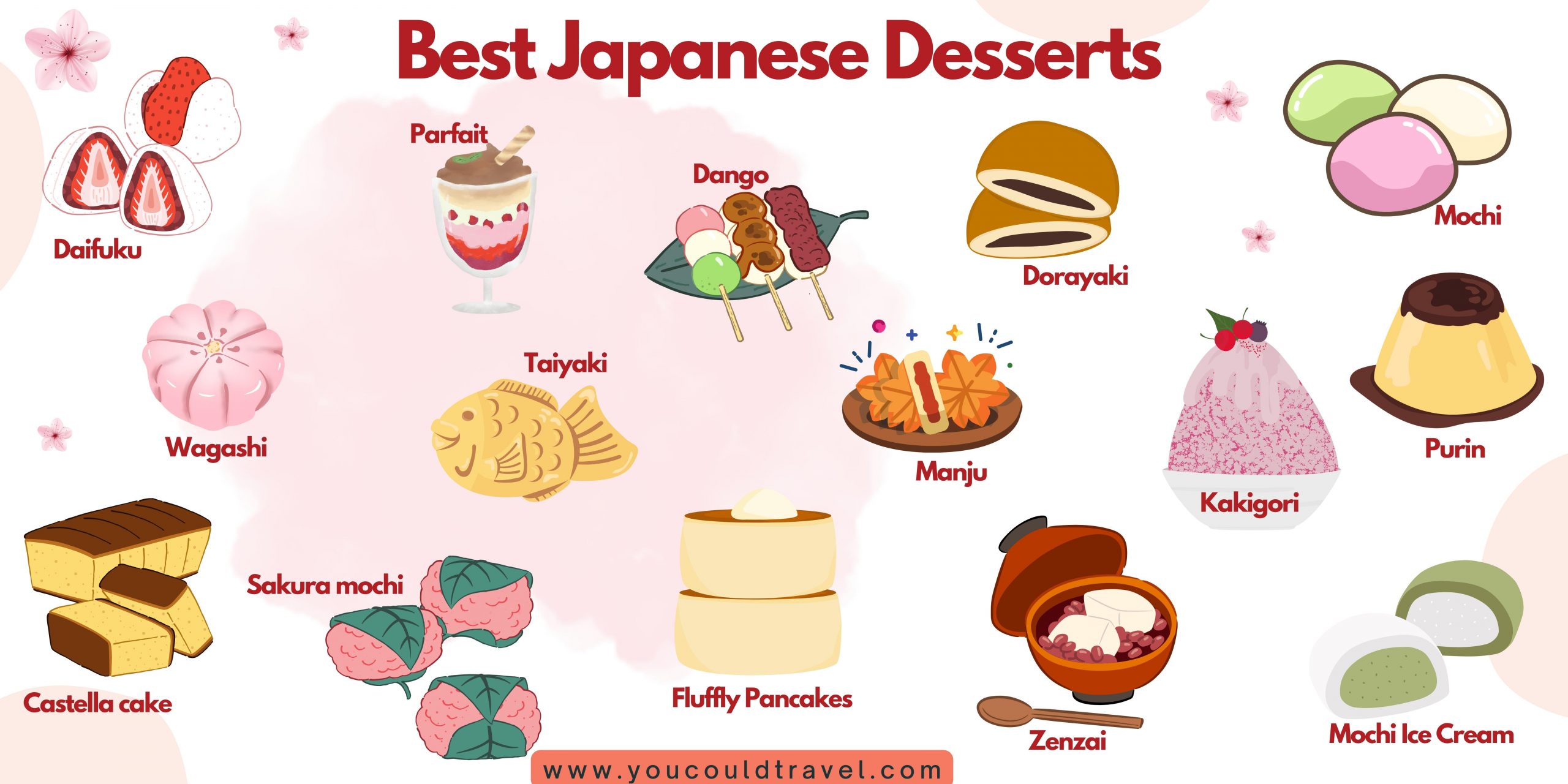
Table of Contents
- Mochi
- Japanese cheesecake
- Matcha ice cream
- Taiyaki
- Dorayaki
- Mizu Yokan
- Isobeyaki
- Manju
- Sakura mochi
- Mochi Ice cream
- Shu cream
- Matcha mille crepe cake
- Japanese pancakes
- Anmitsu
- Daifuku
- Warabimochi
- Dango
- Castella cake
- Kakigori
- Kuzumochi
- Zenzai
- Ohagi (Botomachi)
- Uiro
- Imagawayaki
- Matcha Parfait
- Purin
- Mont Blanc
- Kuri Kinton
- Kintsuba
- Higashi
- Amanatto
- Shingen Mochi
- Suama
- Hanabiramochi
- Final Thoughts
- Frequently Asked Questions
Mochi

Mochi is a traditional Japanese rice cake made from mochigome, a short-grain glutinous rice. Pounded into a paste and moulded into desired shapes, mochi is enjoyed year-round, but is particularly popular during the Japanese New Year.
The history of mochi dates back to ancient China and was introduced to Japan after rice cultivation began during the Jōmon period. Over time, mochi gained cultural significance in Japan, becoming an essential part of celebrations such as childbirth, marriage, and New Year’s festivities.
Mochi’s preparation has evolved over time, with modern methods using sweet rice flour (mochiko) mixed with water and cooked until forming a sticky, white mass. The traditional process, called mochitsuki, involves soaking and steaming glutinous rice before pounding it with wooden mallets and shaping it into forms such as spheres.
Japanese cheesecake
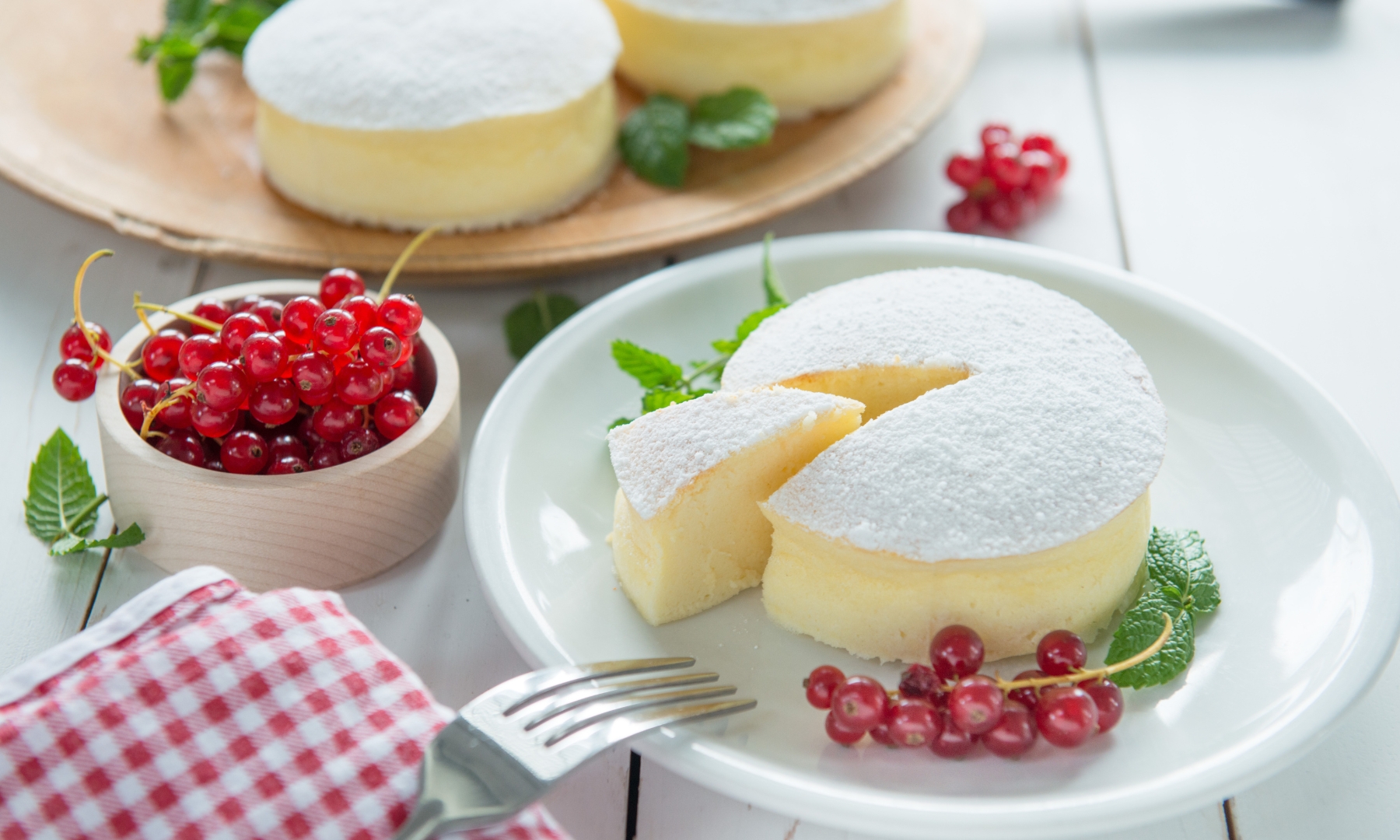
Japanese cheesecake, also known as cotton cheesecake or soufflé cheesecake, is a light and fluffy variation of traditional cheesecake. It is loved for its delicate texture and mildly sweet flavour. Japanese cheesecake is a modern dessert and it strikes a balance between a classic cheesecake and a soufflé. You can find it in many Tokyo cafés and restaurants, especially around Harajuku and Aoyama.
A Japanese cheesecake is typically pale and has a smooth, slightly domed top. It may be dusted with powdered sugar or served with fruit or a fruit sauce for added flavour. You can even find it served with fluffy whipped cream and ice cream.
Matcha ice cream
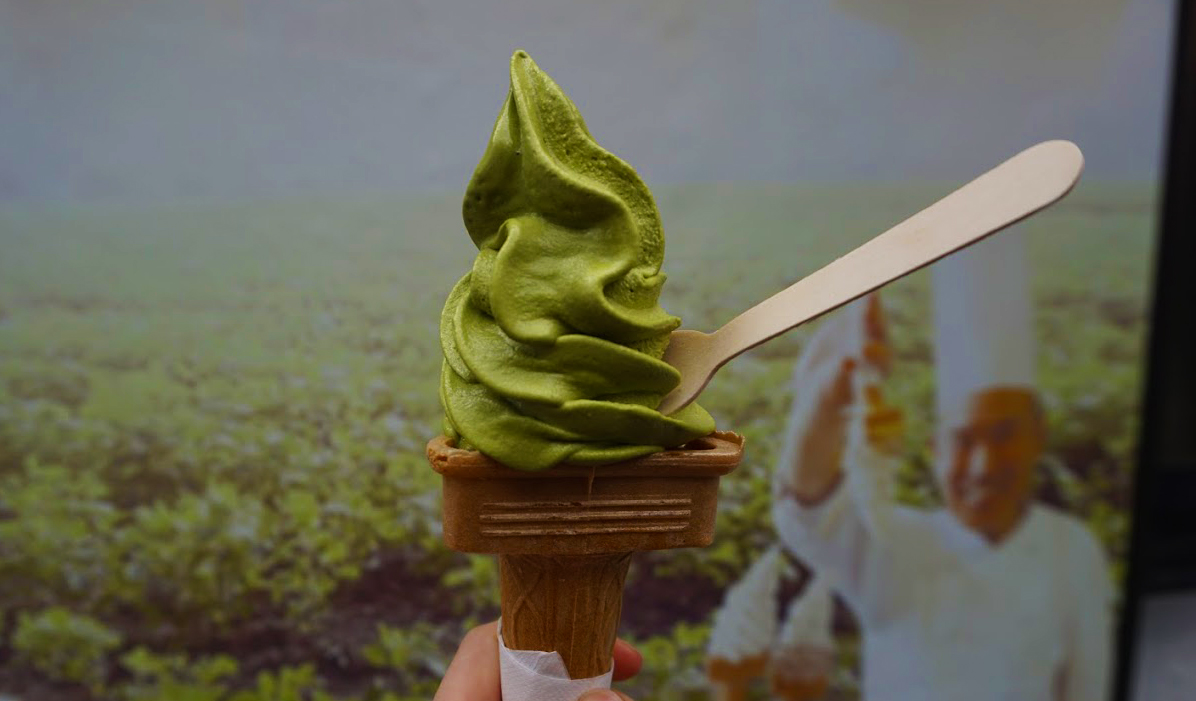
Matcha ice cream is a popular Japanese dessert that combines the distinct, slightly bitter flavour of matcha, a finely ground green tea powder, with the creamy and refreshing qualities of ice cream. The vibrant green colour and earthy, slightly bitter taste of matcha make this dessert stand out from other ice cream flavours.
Now, matcha is incredibly popular in Japan, so you will definitely find it everywhere. Matcha ice cream can be found in almost every ice cream parlour and street food stalls all around the country. It’s especially popular in the streets of Kyoto and Uji.
Traditionally made by blending matcha powder with a mixture of milk, cream, and sugar, the ice cream is churned to create a smooth and velvety texture.
Taiyaki
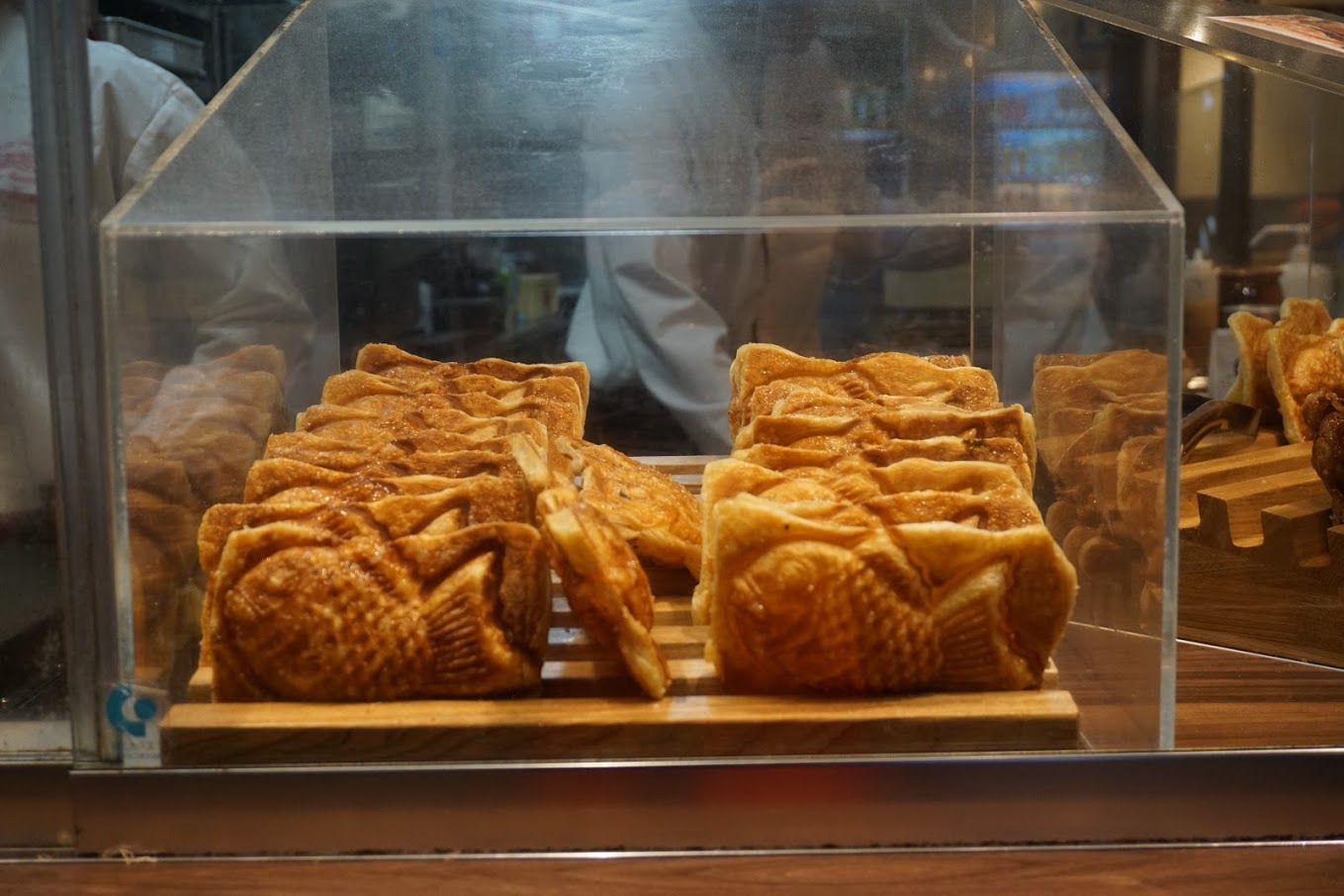
Taiyaki is a classic Japanese street food with a fish-shaped waffle-like pastry filled with various sweet or savoury ingredients. The most traditional filling is a sweet azuki sweet red bean paste, but other popular fillings include custard, chocolate, and even cheese or sweet potato for a savoury twist.
The taiyaki batter is made from a mixture of flour, sugar, baking soda, and water, poured into a fish-shaped mould, and cooked until golden brown and crispy.
The name taiyaki translates to baked sea bream, which is a nod to the fish-shaped appearance of the pastry. You will find taiyaki at various street food stalls. The first time I tried it was in Ameyokocho near Ueno Park.
Dorayaki
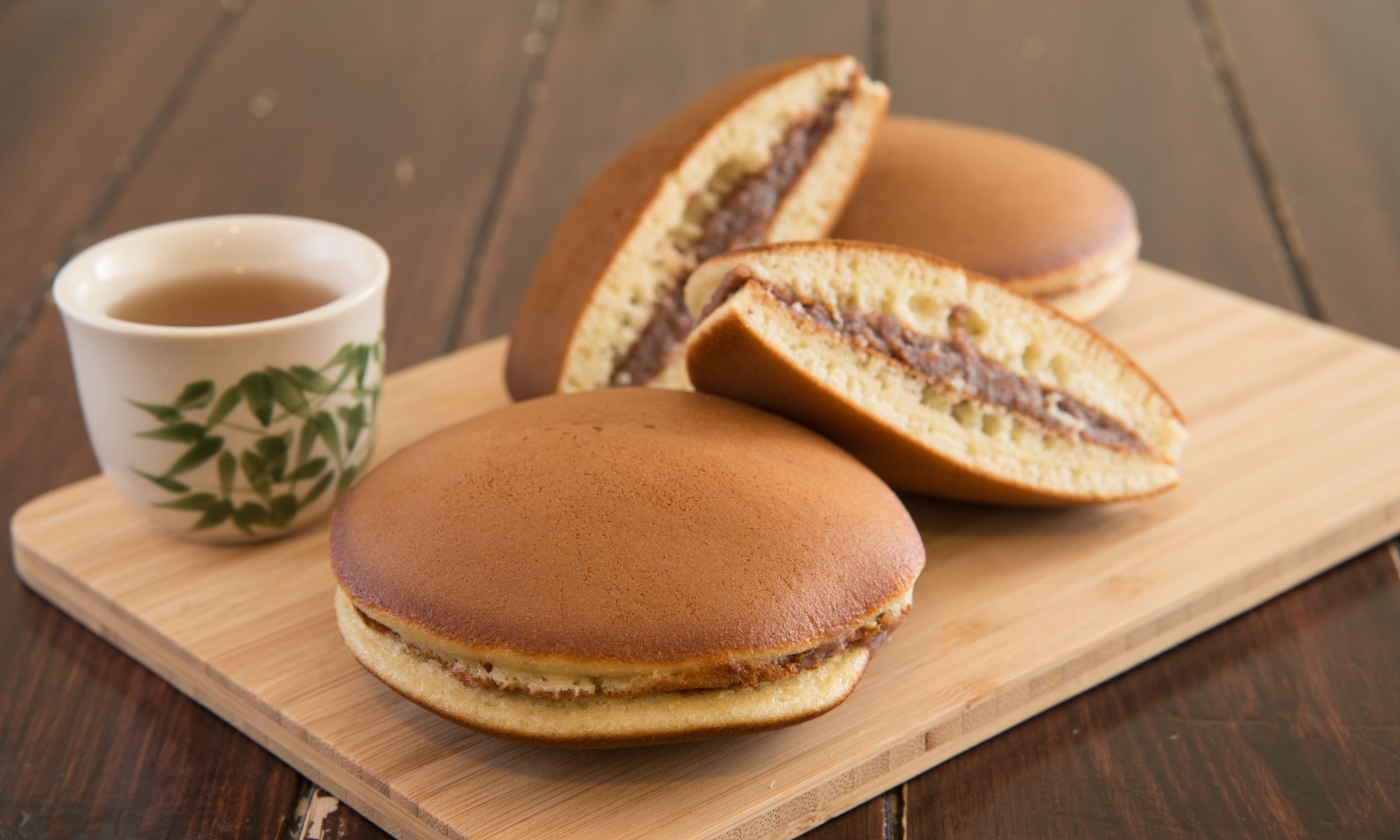
Dorayaki is one of my favourite Japanese desserts, consisting of two fluffy, pancake-like cakes sandwiched together with a sweet filling.
The traditional filling for dorayaki is red bean paste, but it can also be filled with custard, whipped cream, or various fruit jams. I personally like custard dorayaki best.
The history of dorayaki dates back to the 16th century, and it has since become a favourite treat in Japanese culture. It became very popular thanks to the well known manga and anime character Doraemon, who is known for his love of dorayaki.
You can find dorayaki everywhere, including konbini (convenience store in Japanese).
Mizu Yokan

Mizu yokan is a traditional Japanese dessert made from agar-agar, sugar, and adzuki bean paste, resulting in a cool, jelly-like refreshing treat.
The name mizu yokan translates to water yokan, referring to the higher water content compared to regular yokan, which gives it a lighter, more delicate texture.
The subtle sweetness and smooth texture of mizu yokan makes it particularly popular during the hot summer months in Japan. You can find mizu yokan with matcha, honey, black tea, plum and chestnut.
Isobeyaki
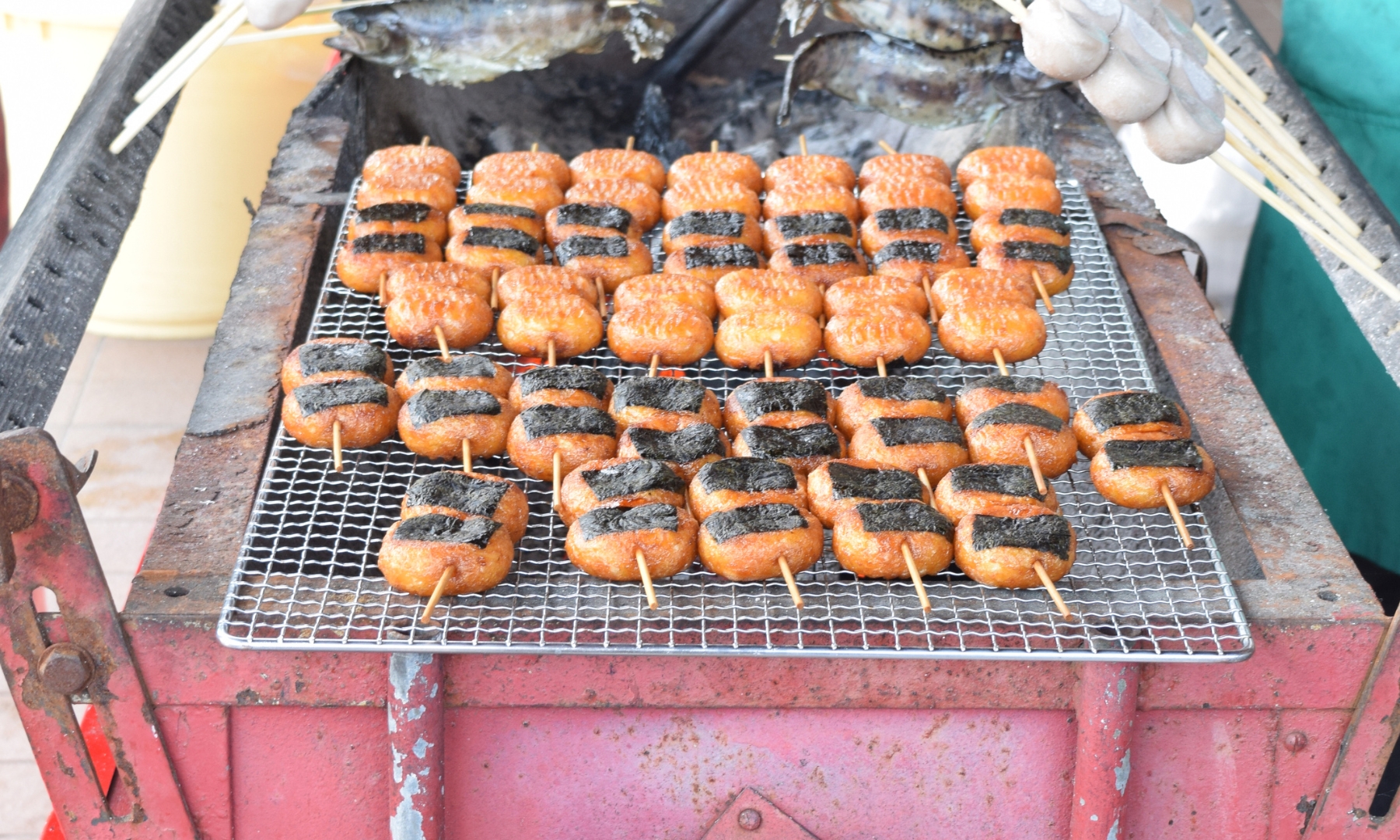
Isobeyaki is a traditional Japanese snack where mochi is wrapped in a sheet of nori (seaweed), and brushed with soy sauce before being grilled or pan-fried. Mochi is cut into small pieces, grilled or pan-fried until crispy on the outside and soft and gooey on the inside. The nori sheet is then wrapped around the mochi, adding a touch of umami and a contrasting texture to the dish.
Isobeyaki is a versatile snack and some prefer it with fillings, like sweet azuki bean paste or savoury ingredients like cheese or vegetables.
Manju

Manju is a traditional Japanese confection made from a soft, steamed bun filled with sweet red bean paste, known as anko. Manju is one of my favourite Japanese desserts and the Hiroshima local Momiji manjū is, in my opinion, the absolute best. You will find it when you stay in Hiroshima or when you explore the nearby island of Miyajima.
Manju comes in various shapes and flavours, with regional variations often incorporating local ingredients like chestnuts, yuzu, or green tea. Momiji manjū, for example, is Japanese maple leaf shaped. Some modern interpretations of manju have unique fillings such as custard, chocolate, or fruit jams. And yes, I do prefer the custard filling, always.
Sakura mochi
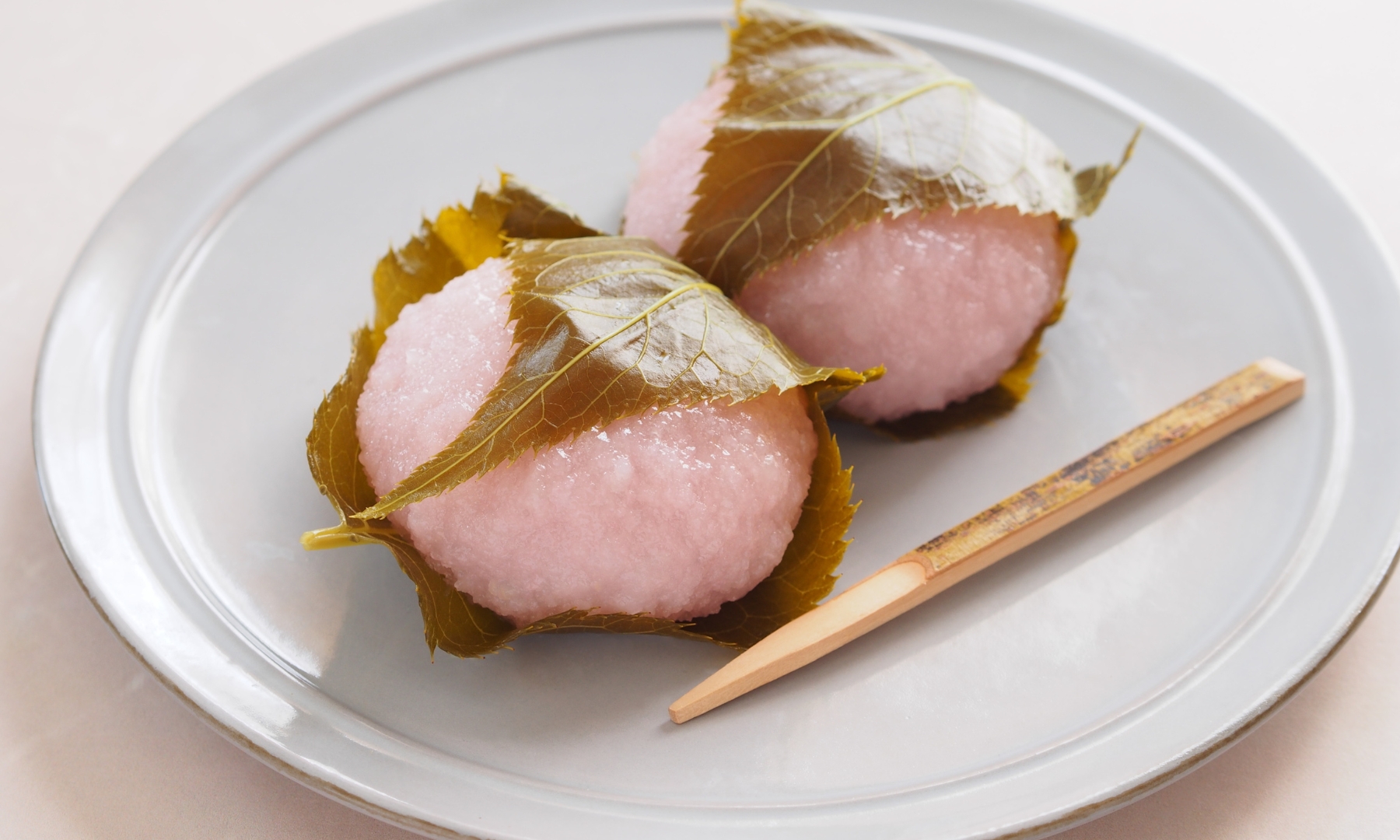
Sakura mochi is a traditional Japanese dessert made from sweet peach-coloured glutinous rice and filled with sweet red bean paste. The dessert is wrapped in a salted cherry leaf, which imparts a subtle, floral fragrance to the mochi.
Sakura mochi is available during springtime, for the cherry blossom season, when the sakura trees are in full bloom. The dessert is associated with Hinamatsuri, also known as the Japanese Doll Festival or Girls’ Day, celebrated on March 3rd each year. There are two regional styles of sakura mochi: Kanto-style, which uses a dough made from glutinous rice flour, and Kansai-style, which uses a dough made from whole glutinous rice grains.
Mochi Ice cream
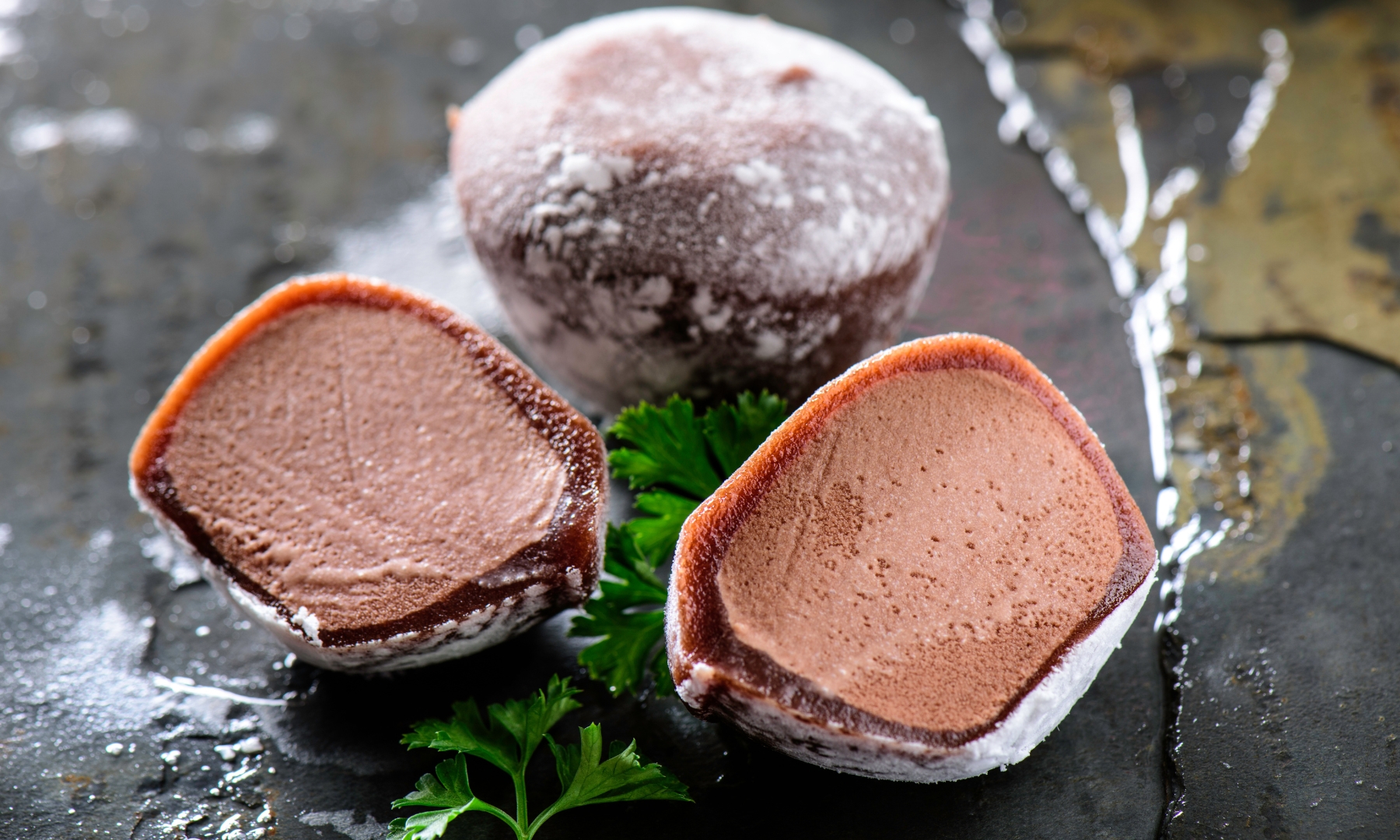
Mochi ice cream is a popular Japanese dessert that combines the chewy texture of mochi with the cool, creamy taste of ice cream.
As you might have seen it abroad, mochi ice cream is basically a small scoop of ice cream wrapped in a thin layer of mochi. You will find traditional and modern Japanese flavours like matcha, red bean, and black sesame, chocolate, vanilla, and strawberry. It’s so popular, you can now find it in most convenience stores around the world.
Shu cream
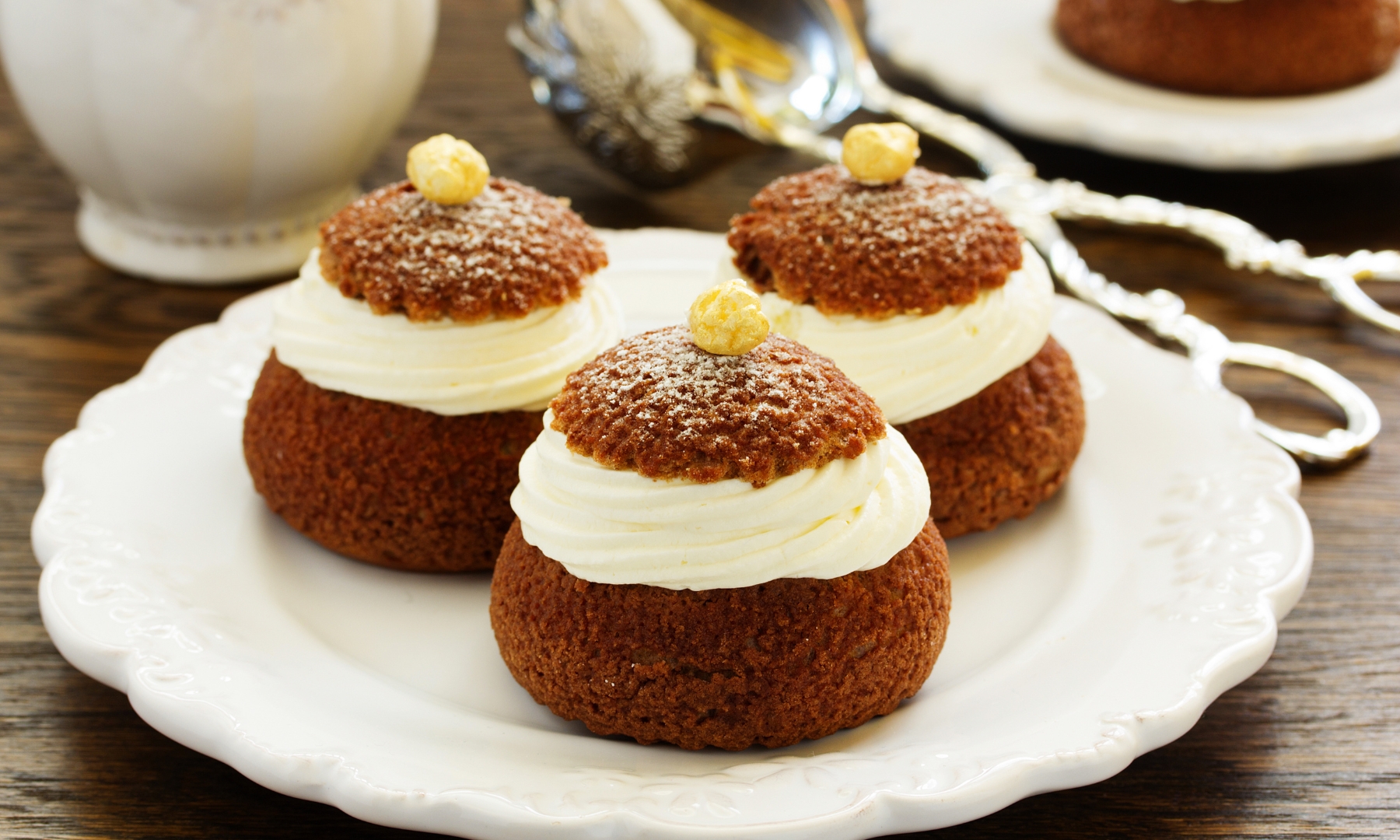
Shu cream, also known as cream puffs or choux à la crème, is a popular dessert in Japan (and France!) with a light and airy pastry shell filled with a sweet cream. The pastry is typically filled with a whipped custard cream, although some modern cafes now use matcha-infused cream, azuki bean cream, and fruit-flavoured creams.
I even found yuzu and black sesame shu creams in Japan which looked and tasted amazing. Hop Shu-Kuri-Mu is a popular pastry shops in Tokyo which specialises in shu cream. And for Studio Ghibli fans, a trip to Shiro-hige’s Cream Puff Factory is a must as the shop specialises in Totoro shaped cream puffs.
Matcha mille crepe cake

Attention, this is the most delicious and honestly addictive Japanese dessert ever. It’s so good! Matcha mille crêpe cake is a stunning and sophisticated dessert that features a stack of delicate, paper-thin crêpes layered with a velvety, matcha-infused cream. The word “mille” means a thousand in French, signifying the many layers that make up this cake. While it doesn’t have a thousand layers, it typically consists of 20 to 30 crêpes (done to perfection). The use of matcha, a finely ground green tea powder, gives the dessert a stunning green hue and imparts a rich, earthy flavour that balances the sweetness of the cream.
And yes you can find this with strawberry or chantilly cream instead. Making a matcha mille crepe cake requires skill and patience, as each crepe must be cooked individually and cooled before being layered with the cream filling. Once assembled, the cake is chilled to set the layers and allow the flavours to meld. When it’s ready to serve, the cake is often dusted with a light layer of matcha powder and sometimes garnished with fresh fruit, edible flowers, or a drizzle of syrup. I’m so hungry right now!
Japanese pancakes
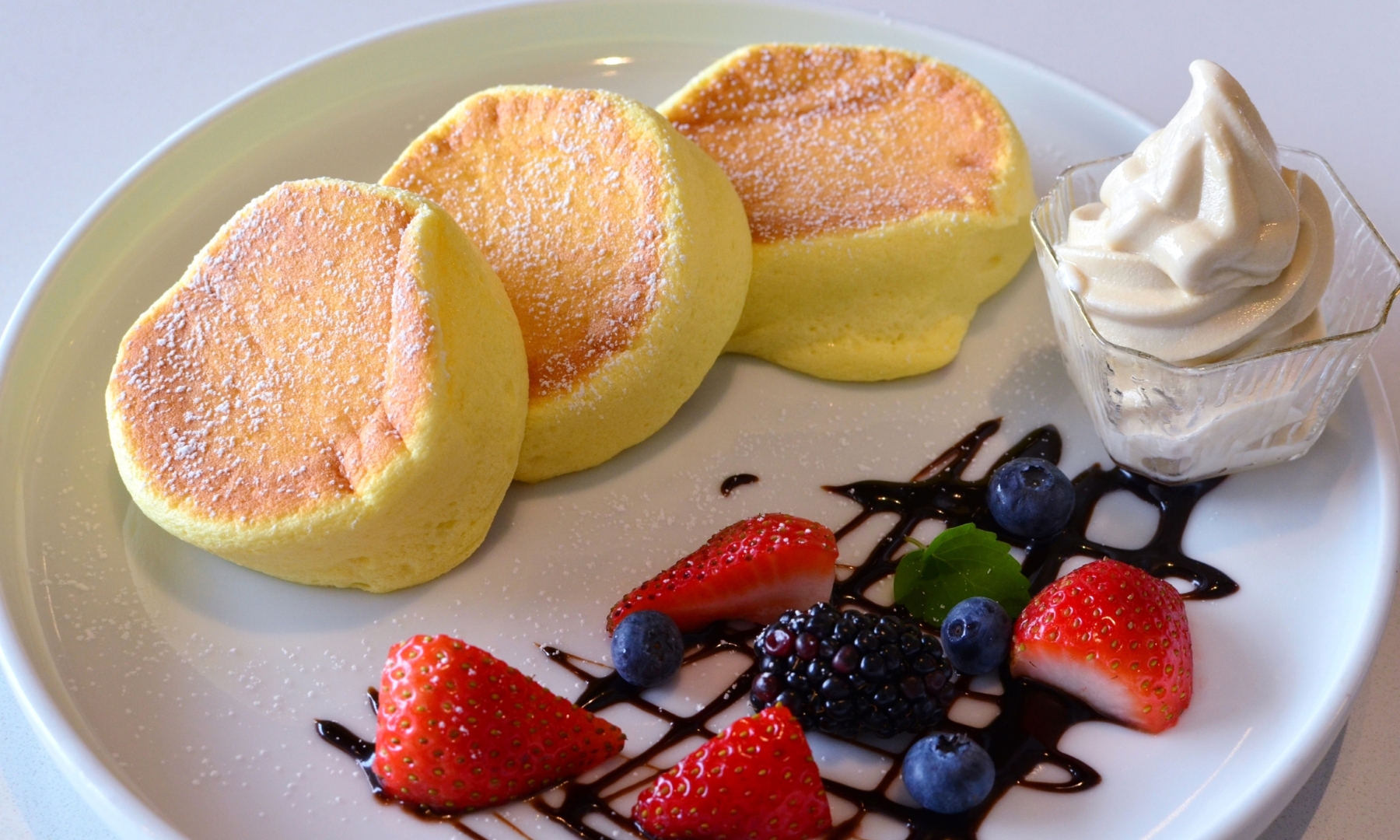
Japanese pancakes, also known as hotcakes or soufflé pancakes, are thick, fluffy, and cloud-like. They differ from traditional American pancakes, which are generally thinner and denser. Japanese pancakes are made with eggs, flour, sugar, milk, and a leavening agent like baking powder, which creates their signature airy texture.
The key to making ideal Japanese pancakes which are perfect in height and fluffiness is in the preparation. The egg whites are whipped separately from the yolks and then gently folded into the rest of the batter, resulting in a light and airy mixture. The pancakes are cooked on low heat, sometimes using a mold to maintain their shape, and are covered to steam and rise as they cook.
You will find Japanese pancake cafes in Japan. For Tokyo, Harajuku is a hot spot for these fluffy delights.
Anmitsu

Anmitsu is a traditional Japanese dessert that has been enjoyed for centuries, dating back to the Meiji Era. It is a refreshing, light, and versatile dish that consists of small cubes of agar-agar jelly served with sweet ingredients such as azuki bean paste, mochi, fruits and even pieces of green tea or ice creams. The dish is drizzled with a sweet black sugar syrup called “kuromitsu,” which adds a rich, caramel-like flavour and brings all the components together.
In Japan, anmitsu can be found in traditional tea houses and specialty dessert cafes.
Daifuku
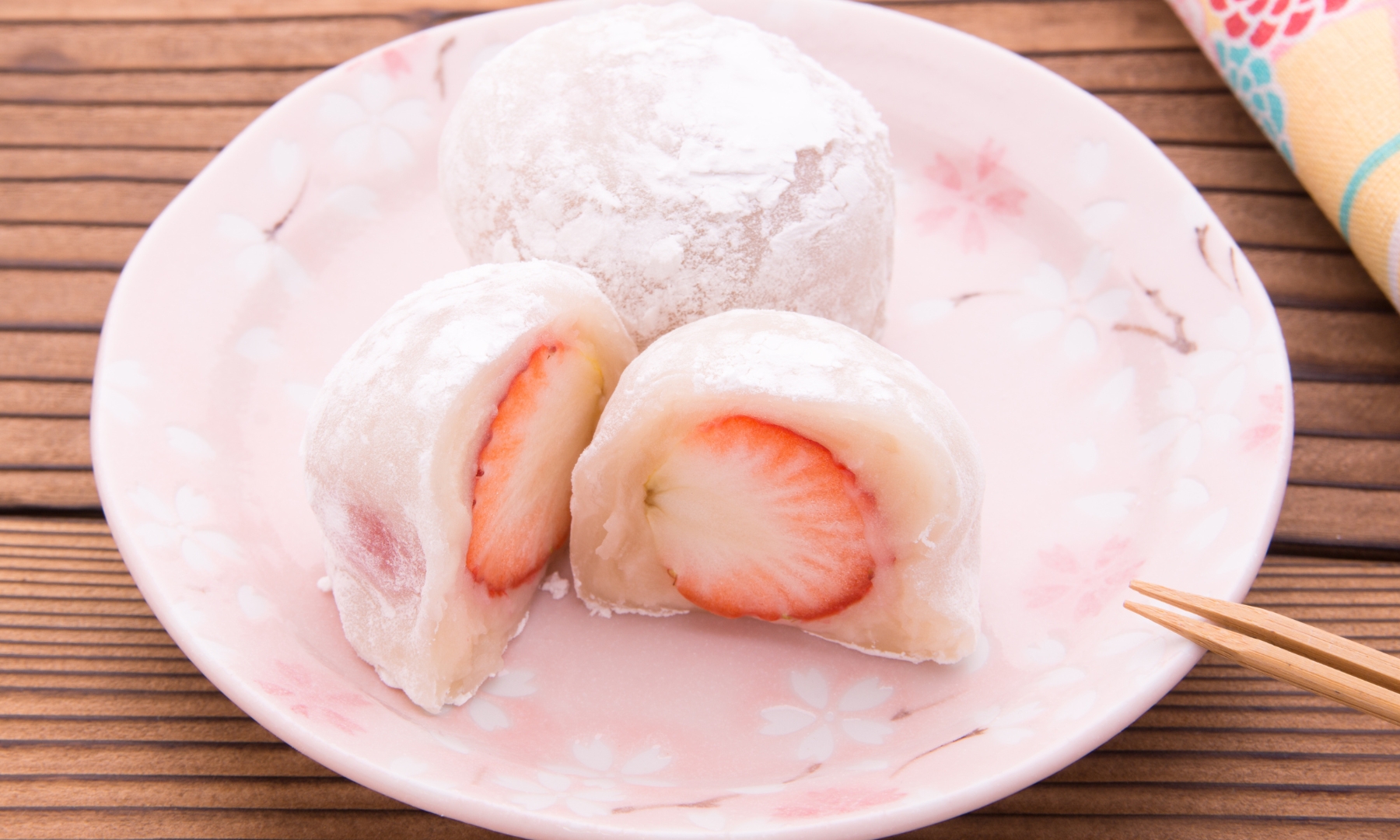
Daifuku is made from mochi and filled with either anko, custard, chocolate or yuzu. Some popular variations are strawberry daifuku, which contains a whole strawberry surrounded by anko, and yomogi daifuku, which incorporates mugwort leaves into the mochi dough for a distinctive green colour and earthy flavour.
The name “daifuku” translates to “great luck,” making it a symbol of good fortune in Japanese culture.
The finished daifuku is often dusted with a light coating of potato starch or cornstarch to prevent sticking.
Warabimochi

Warabimochi is a unique dessert made from warabi-ko (bracken starch) and water, resulting in a translucent, jelly-like confection with a slightly chewy texture. It is believed to have originated in the Kansai region of Japan and is particularly popular during the hot summer months due to its cool, refreshing taste and texture.
Warabimochi is cut into small cubes or shapes and served with a dusting of kinako, a roasted soybean flour that adds a nutty, sweet flavour. It’s not uncommon to get warabimochi drizzled with kuromitsu, a sweet black sugar syrup.
Dango

Dango is a popular Japanese dessert made from small, round dumplings of sweet rice flour, served skewered on a bamboo stick. Dango comes in various flavours and preparations, with some of the most popular types being mitarashi dango, which is coated in a sweet soy sauce glaze; hanami dango, which is served during cherry blossom season and features tri-coloured dumplings in pink, white, and green; and anko dango, which is filled with sweet red bean paste.
Dango can be enjoyed year-round and is often associated with festivals, seasonal celebrations, and traditional teahouses. It is also a popular street food, with vendors selling freshly grilled or boiled dango from carts or stalls.
One unique variation of dango is the regional specialty, Goma Dango, which is made by coating the rice dumplings with a mixture of sesame seeds and sugar, giving them a nutty, crunchy exterior. Another version, Shiratama Dango, is made from pure glutinous rice flour and often served with fruits, ice cream, or other sweet accompaniments as a dessert.
Castella cake
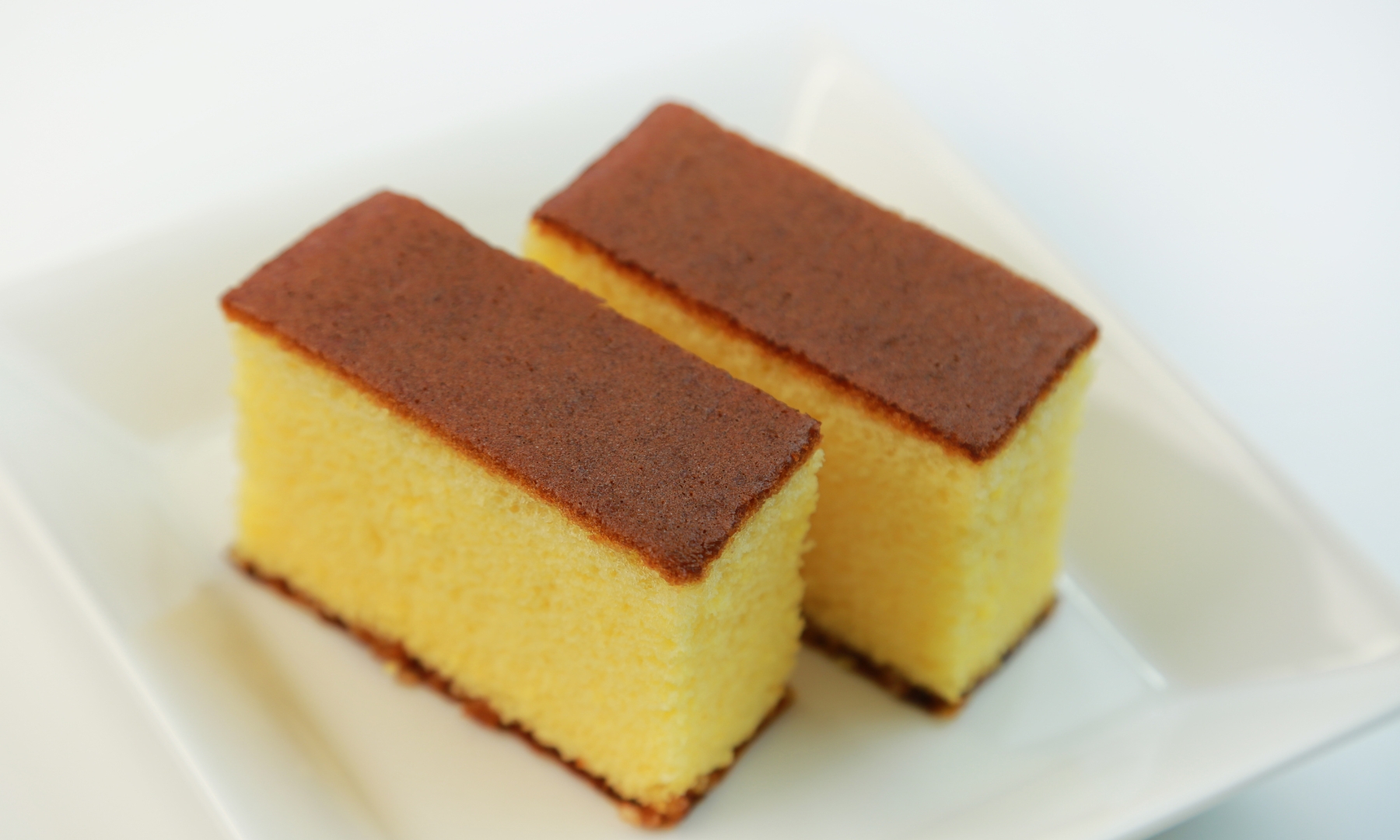
Castella is a Japanese sponge cake that traces its origins back to the 16th century when Portuguese merchants introduced it to Japan. This soft, moist cake is made from simple ingredients and has a delicate, sweet flavour with a subtle hint of honey.
The cake is traditionally baked in a rectangular mold, resulting in a dense, fine-textured crumb. After baking, the cake is often wrapped in paper or plastic to retain its moisture. Castella is popular throughout Japan and has become a regional specialty in Nagasaki, where it is known as Nagasaki Castella.
Kakigori

Kakigori is a traditional Japanese shaved ice dessert that has been enjoyed for centuries, particularly during the hot summer months. You will find it in kakigori shops in more traditional neighbourhoods like Yanaka Ginza, where the art of shaving the ice is often showcased through a variety of unique techniques and presentations. The dessert is made by shaving ice into a delicate, fluffy texture, and then topping it with flavoured syrups, sweetened condensed milk, or fruit purees.
Classic flavours for kakigori include strawberry, melon, and lemon, but modern interpretations offer a wide range of flavours such as matcha, azuki, and even black sesame.
Kuzumochi
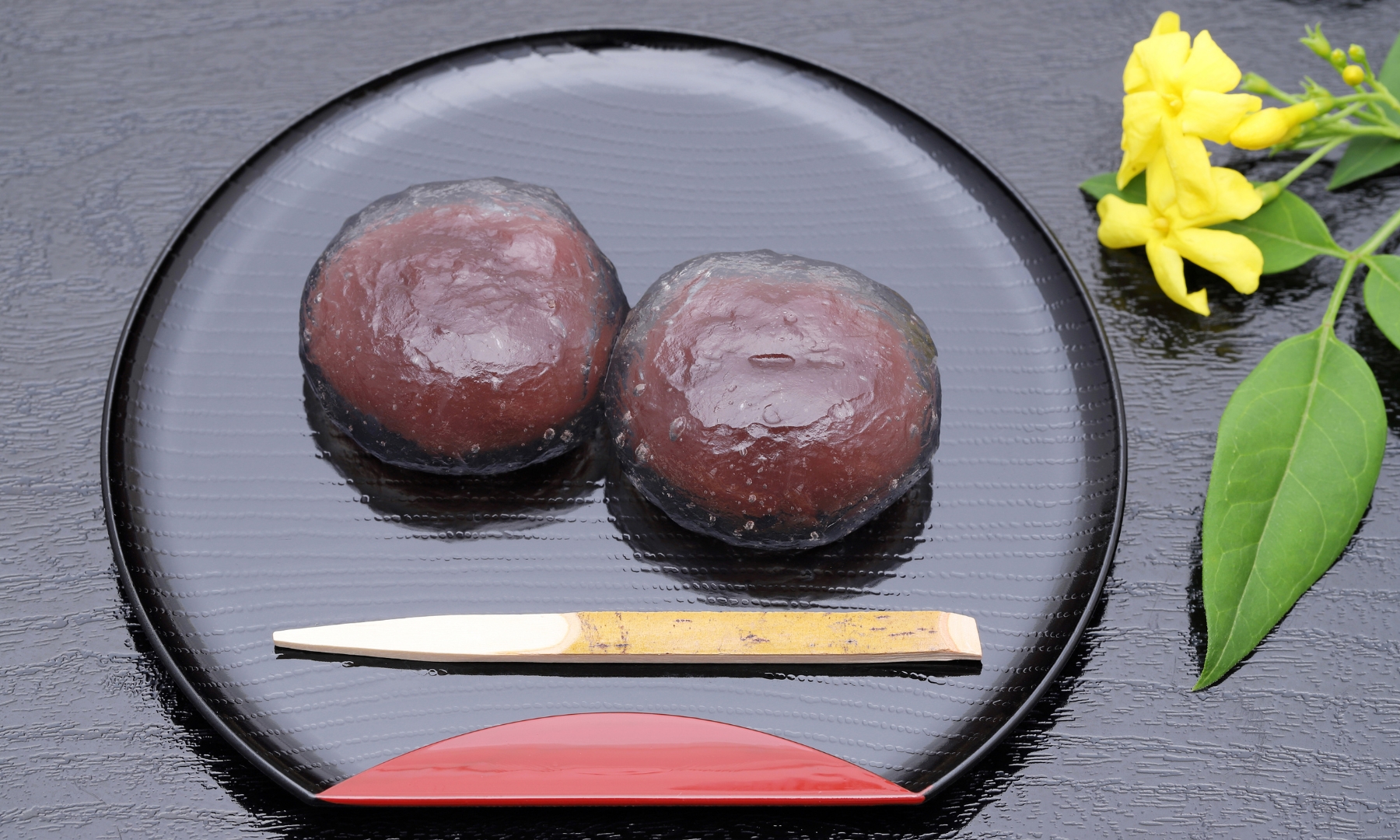
Kuzumochi is a traditional dessert made from kuzu starch, which is extracted from the roots of the kudzu plant. The dessert is translucent and has a jelly-like texture with a mild, slightly sweet flavour.
To prepare kuzumochi, the kuzu starch is mixed with water and sugar, and then heated until it thickens and becomes translucent. The mixture is poured into a mold and allowed to cool and set. Once set, the kuzumochi is cut into small pieces and served with a dusting of kinako (roasted soybean flour) and a drizzle of kuromitsu (a sweet black sugar syrup).
Zenzai
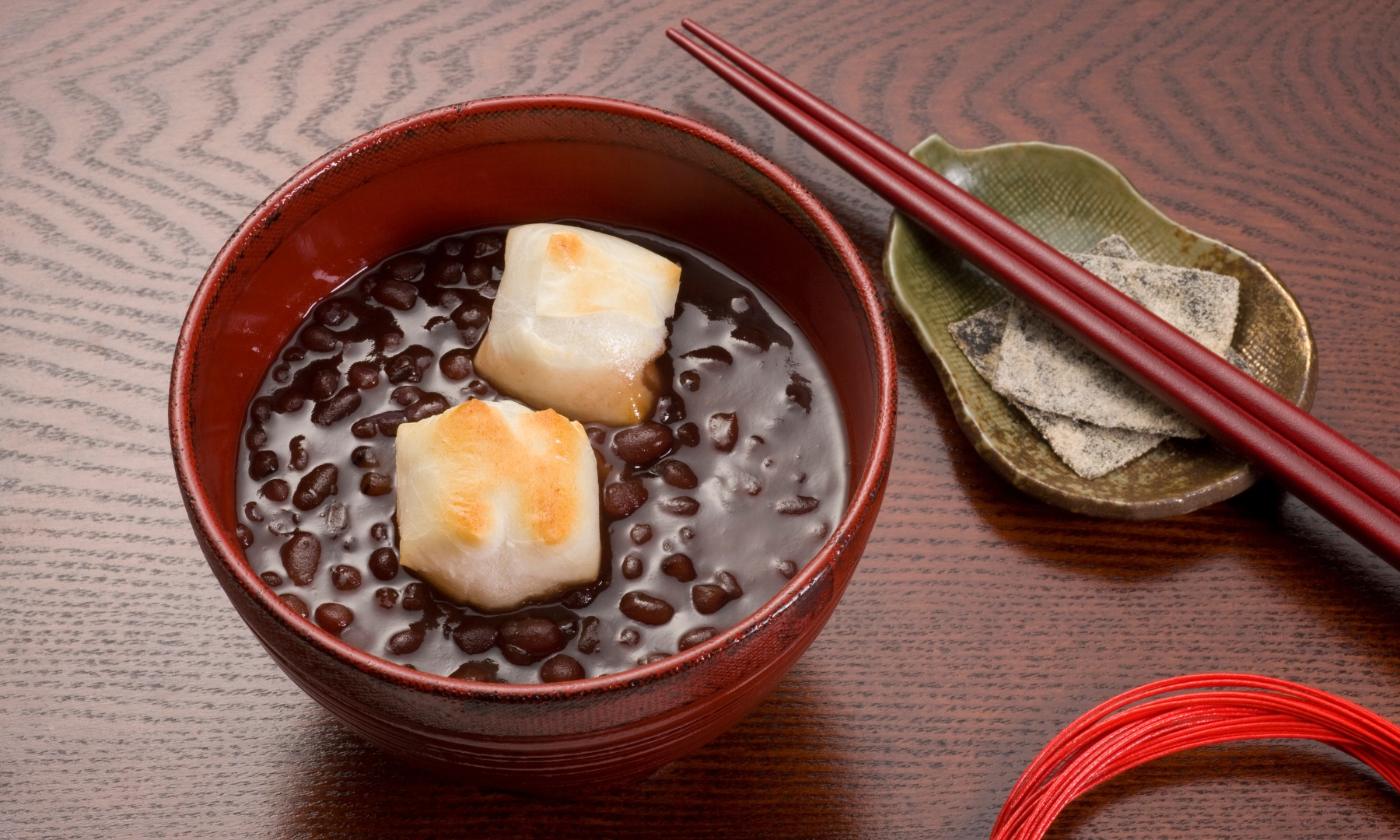
Zenzai is a Japanese dessert made from sweetened adzuki bean soup, served with mochi or rice cakes as toppings. The dish is typically enjoyed during the colder months as a warm, comforting treat.
Zenzai is commonly served in bowls and enjoyed with a spoon, accompanied by green tea. It is a popular dessert at Japanese teahouses.
Ohagi (Botomachi)
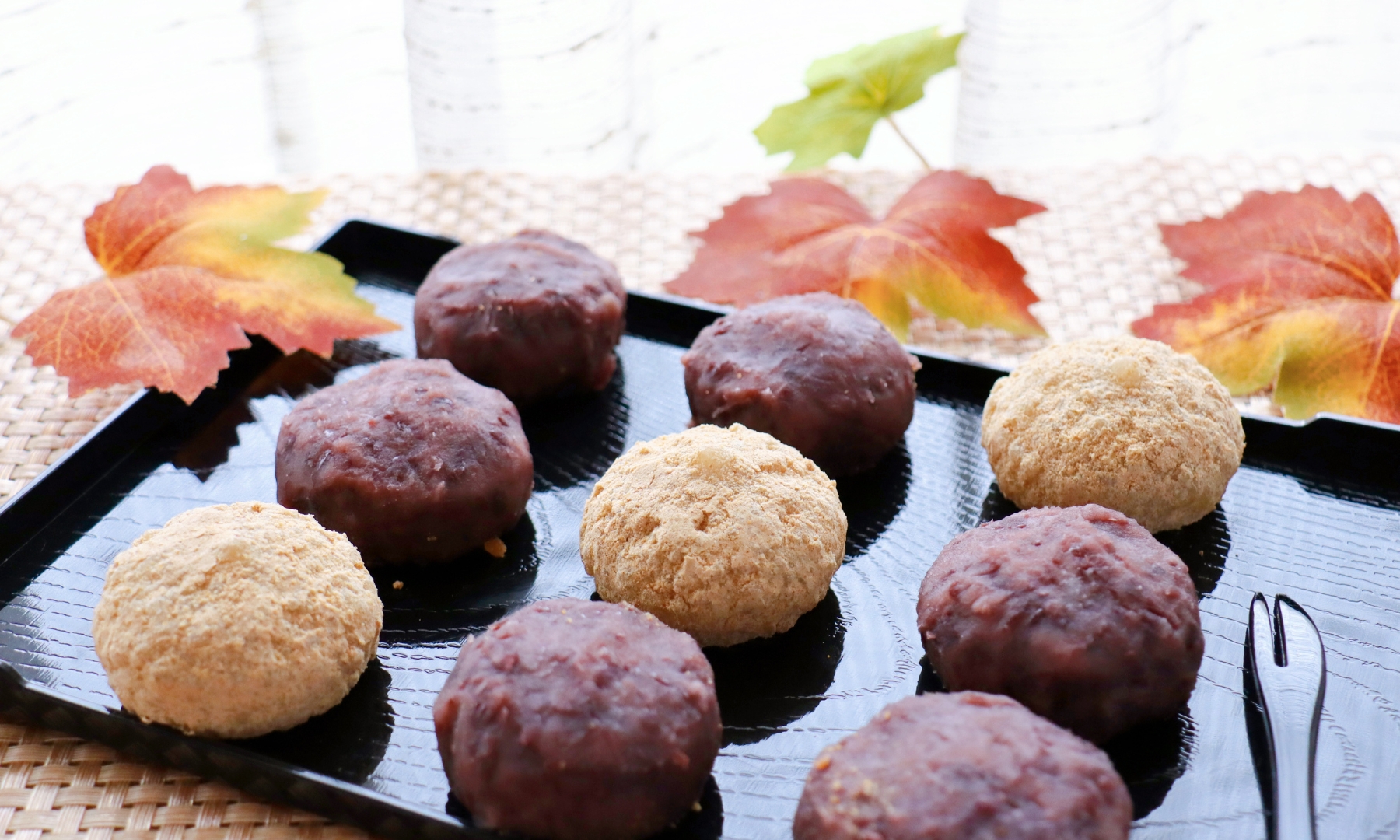
Ohagi is a traditional dessert made from glutinous rice and sweet azuki bean paste. It is typically enjoyed during seasonal celebrations, such as the Higan holidays in spring and autumn. Ohagi is named after the autumn flower “hagi” (bush clover), which blooms during the season when the dessert is commonly consumed. In the spring, the same dessert is called Botomachi, from the spring flower, Botan which is a peony.
There are two main types of anko used for ohagi: koshian (smooth red bean paste) and tsubuan (chunky red bean paste). The rice balls can also be coated with kinako (roasted soybean flour) or sesame seeds for a different flavour and texture.
Uiro
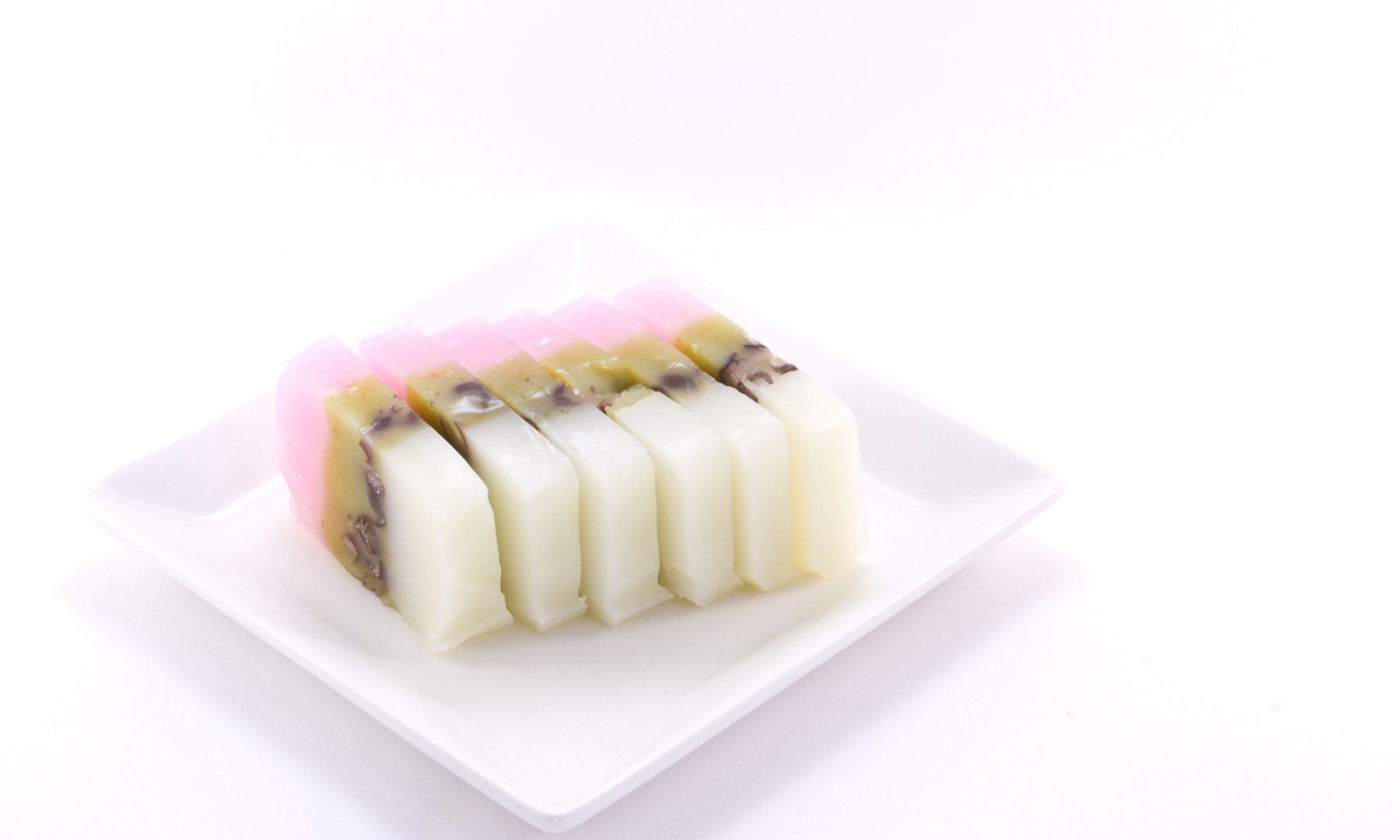
Uiro is a wagashi, a Japanese steamed cake made from rice flour and sugar. The dessert originated in the Nara period (710-794) and has become a regional specialty of Nagoya, where it is known as Nagoya Uiro.
Uiro has a subtle sweetness and a unique texture that falls somewhere between a cake and a mochi. It is often enjoyed with tea or as a light snack.
Imagawayaki

Imagawayaki, also known as obanyaki, is a popular Japanese street food that consists of a pancake-like batter cooked in a special griddle with a sweet filling. The dessert is said to have originated in the Edo period (1603-1868) and is named after the Imagawabashi bridge in Tokyo, where it was first sold.
The dessert is crispy on the outside and soft on the inside, with a warm, sweet filling. Imagawayaki can be found at street food stalls, festivals, and specialized shops across Japan.
Matcha Parfait
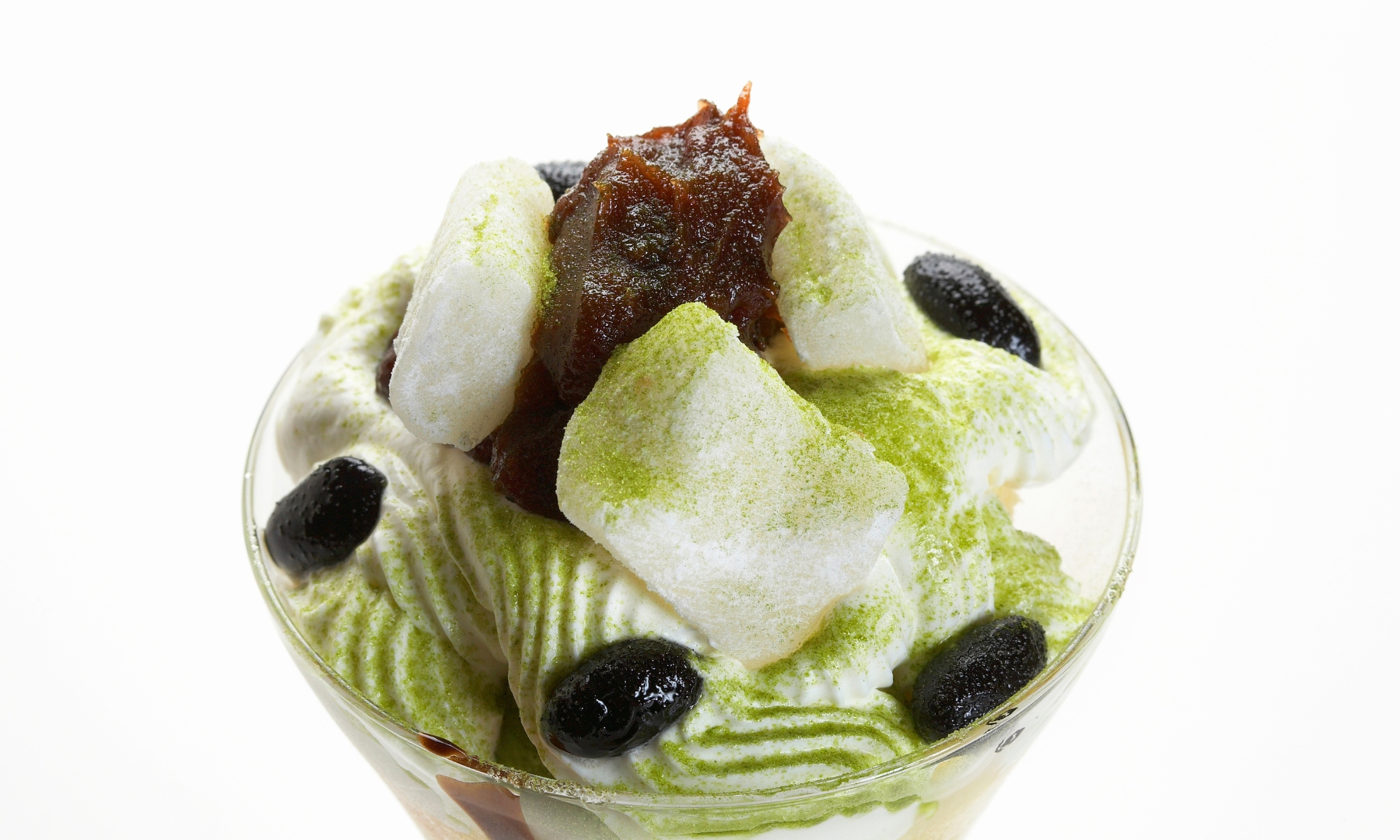
Matcha parfait is a modern Japanese dessert that combines layers of matcha-flavoured elements with various textures and flavours. It is a visually appealing dessert often served in tall glasses to showcase the colourful layers. I especially recommend trying the parfait at the Palace Hotel in Tokyo.
A typical matcha parfait may include layers of matcha sponge cake, matcha ice cream or gelato, matcha mousse, and whipped cream. Other Japanese parfait will have lots of fruits decorations. The dessert can be customized with additional elements like green tea jelly, matcha brownies, or matcha panna cotta.
Purin
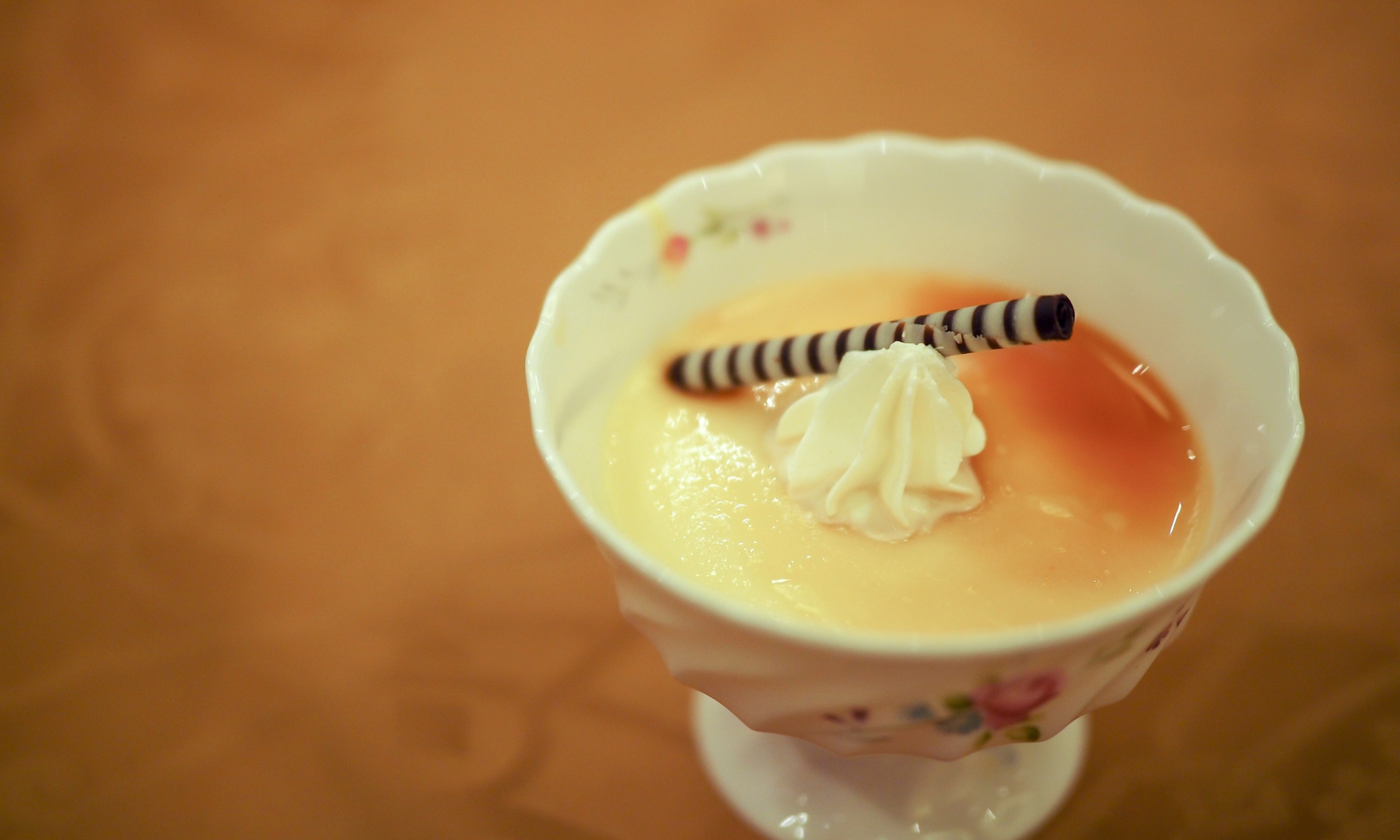
Purin is a Japanese custard pudding, and a very popular dessert that resembles a cross between flan and crème caramel. Purin is silky and smooth in texture with that perfect caramelized sugar topping.
Purin comes in many flavours, such as matcha, chocolate, and coffee. It is widely available at convenience stores, bakeries, and dessert shops throughout Japan.
Mont Blanc

Mont Blanc, or Mont-Blanc aux Marrons, is a French dessert that has become popular in Japan with its own unique twist. The dessert is named after the highest peak in the Alps, Mont Blanc, due to its resemblance to a snow-capped mountain.
The Japanese version of Mont Blanc consists of a base made from sponge cake, tart shell, or meringue, topped with a generous mound of sweetened chestnut puree. The puree, made from boiled and mashed chestnuts mixed with sugar and butter, is typically piped onto the base in a delicate, vermicelli-like pattern to create the appearance of a mountain.
Inside the chestnut puree, there may be additional layers of whipped cream, custard, or fruit to add more flavours and textures. The dessert is often garnished with a whole or halved chestnut and a dusting of powdered sugar to resemble snow.
The best Mont Blanc I’ve had in Tokyo was at the cafe in Nezu Museum.
Kuri Kinton
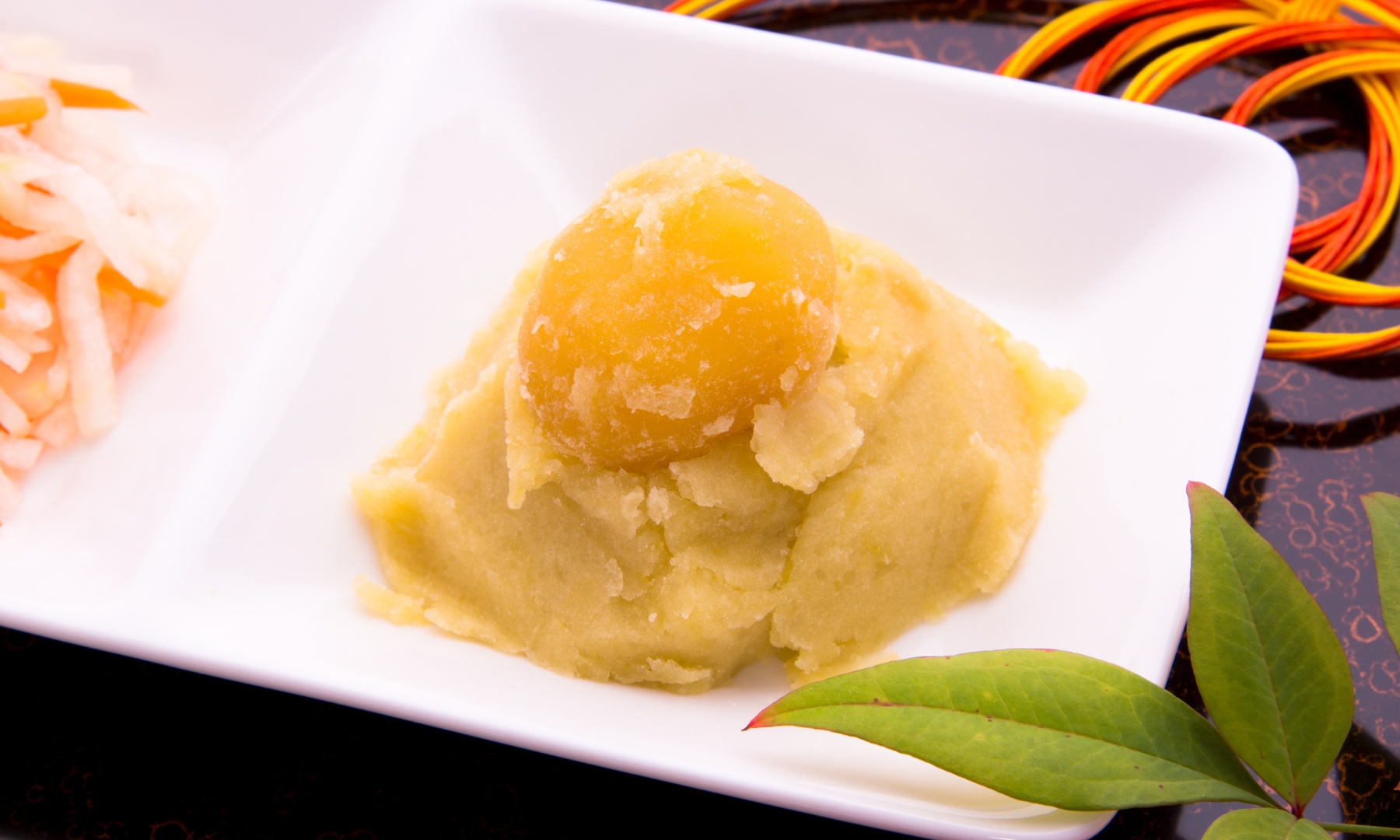
Kuri Kinton is a Japanese confectionery made from sweetened chestnut puree and sweet potato and eaten during the New Year celebration. The name “kuri” means chestnut, and “kinton” refers to a golden mash, representing the yellow-gold colour of the dessert. Kuri Kinton symbolizes good fortune and financial prosperity in the upcoming year.
Kuri Kinton is a deliciously sweet and starchy confection. Kuri Kinton is often molded into shapes or served alongside other Japanese sweets during the New Year.
Kintsuba

Kintsuba is a Japanese wagashi made from a sweet bean paste filling, such as azuki (red bean) paste or white bean paste, surrounded by a thin layer of wheat flour dough. Kintsuba translates to “golden sword guard,” as its rectangular shape and golden-brown colour resemble the hilt of a sword.
The dough is cooked on a griddle, giving it a slightly crispy texture on the outside while maintaining a soft, smooth filling on the inside. Kintsuba is served with green tea and can be found in various forms, including the use of different bean paste flavours, such as matcha, chestnut, or sesame. This traditional confectionery can be found at wagashi shops, tea houses, and even in supermarkets.
Higashi

Higashi is a Japanese wagashi that is dry and contains very little moisture. It is made primarily from sugar, rice flour, and sometimes other ingredients such as wasanbon (a high-quality sugar), agar, or mizuame (a sweetener made from starch).
Higashi is served with tea, particularly during the Japanese tea ceremony, as its sweetness complements the bitterness of the tea. The best Higashi I have had so far was from Japanese shops near Fushimi Inari Shrine, in Kyoto.
Higashi comes in various shapes, colours, and flavours, often reflecting the seasons, flowers, or other natural motifs. It is usually molded, cut, or pressed into intricate designs, making it as visually appealing as it is tasty. It’s a perfect Japanese souvenir for family and friends too.
Amanatto
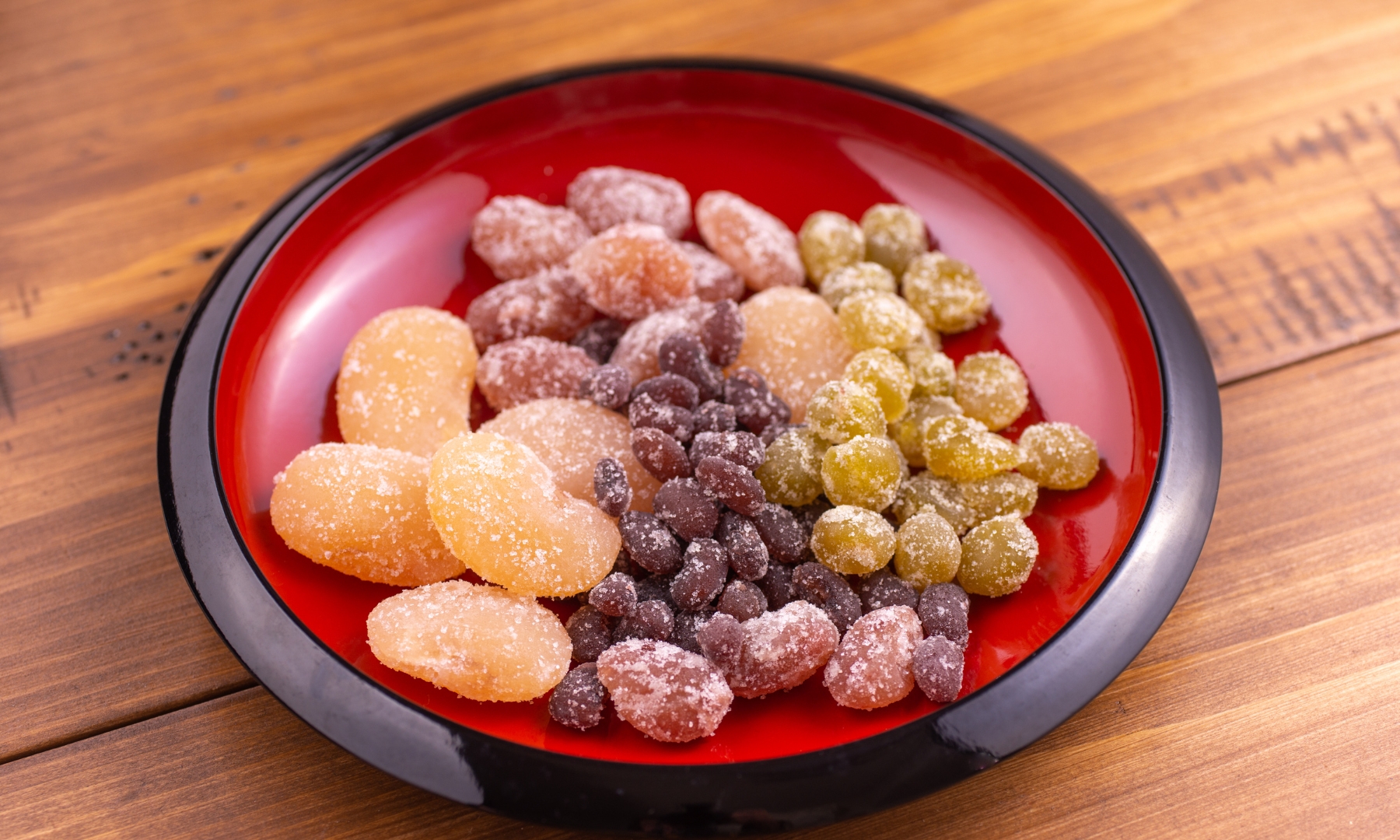
Amanatto is a traditional Japanese confectionery made from beans, such as azuki, kidney, or white beans, that are simmered in sugar syrup and then coated with sugar. The beans are boiled, drained, and then rolled in sugar before being dried, creating a sweet, chewy treat with a slightly crunchy exterior.
Amanatto comes in various colours and flavours, depending on the type of bean used and any additional flavourings. The beans may be coloured with natural ingredients like gardenia fruit or cochineal for added visual appeal. Amanatto is used as a snack or as a topping for other popular Japanese desserts, such as anmitsu or shaved ice.
In recent years, amanatto has gained popularity as a healthier alternative to other sugar-based sweets, as it relies on the natural sweetness of the beans, combined with a relatively small amount of added sugar.
Shingen Mochi
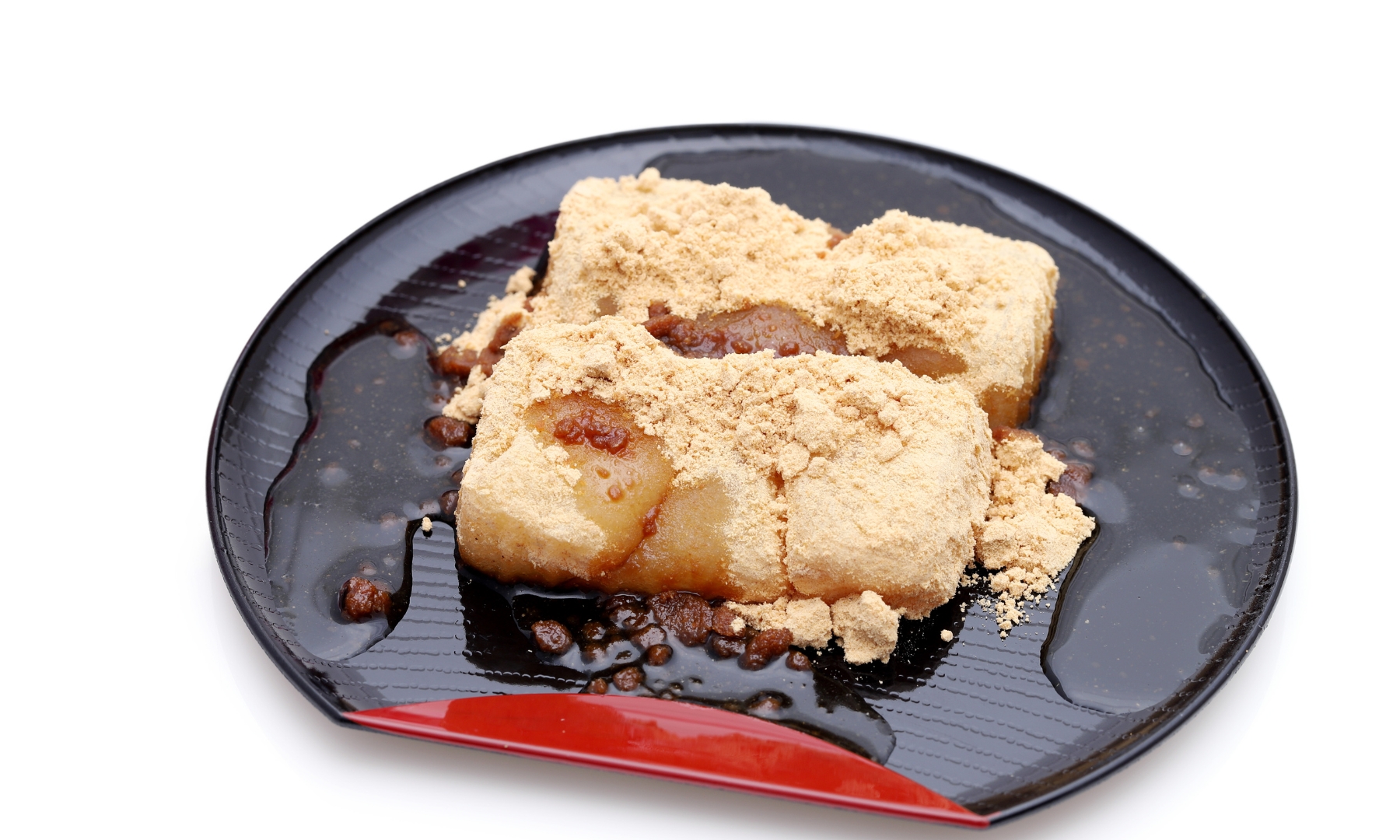
Shingen Mochi is a Japanese dessert originating from the Yamanashi Prefecture. It is named after the famous warlord Takeda Shingen and is made from gyuhi, a soft and delicate type of mochi. The dessert is typically served with a generous amount of kinako (roasted soybean flour) and kuromitsu (a sweet black sugar syrup).
To enjoy Shingen Mochi, take a piece of the soft mochi, coat it in the kinako, and then drizzle it with kuromitsu. The combination of the chewy mochi, nutty kinako, and sweet kuromitsu creates a delicious and satisfying treat.
Suama
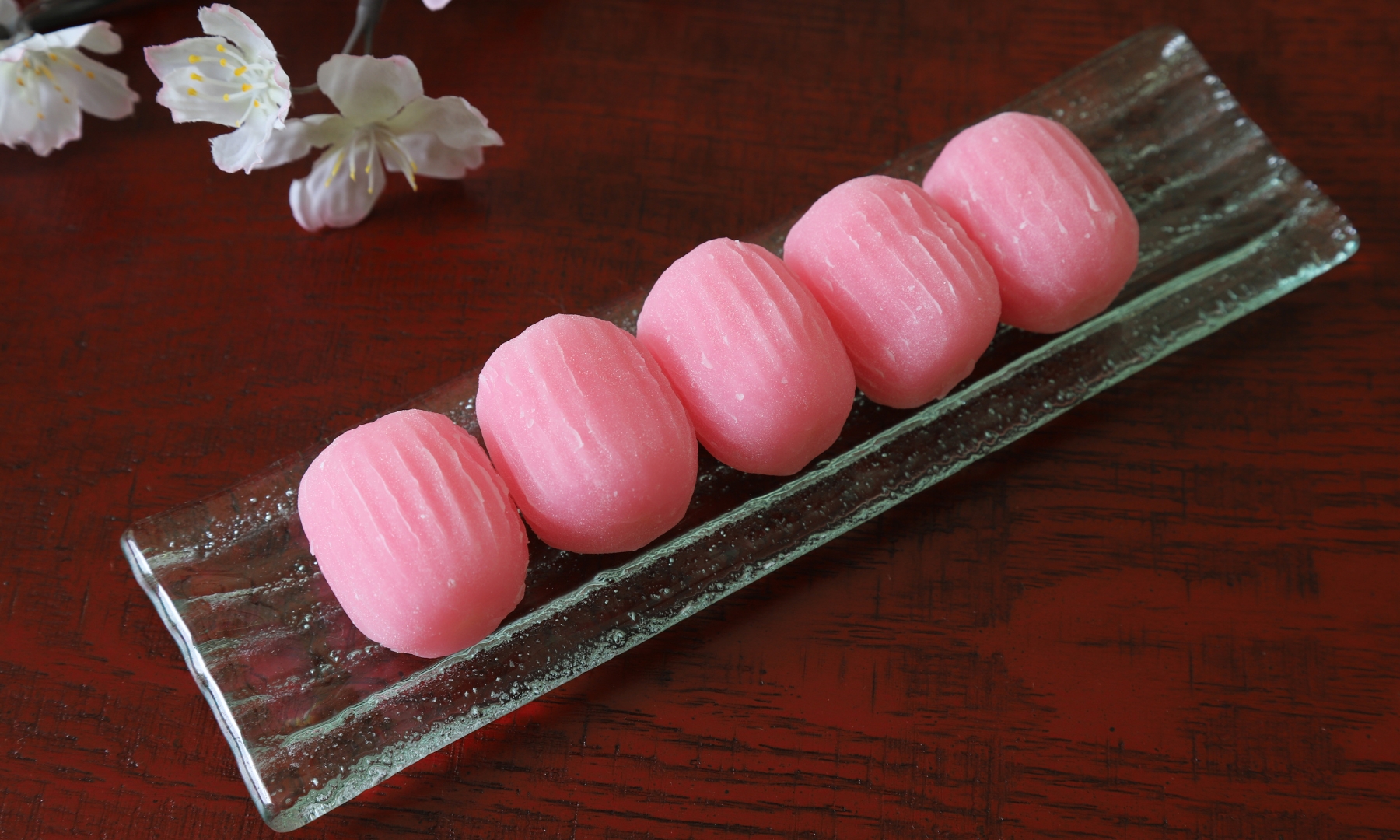
Suama is a Japanese confectionery made from non-glutinous rice flour and sugar. It is characterized by its smooth texture and subtle sweetness. Suama is steamed and then shaped into a flat, rectangular or square form, often with rounded edges. It is commonly dyed in various shades of pink or red, making it visually appealing and suitable for festive occasions.
Suama is perfect with a cup of green tea, as its gentle sweetness complements the tea’s bitterness. This delicate wagashi can be found at traditional confectionery shops, tea houses, and some supermarkets in Japan.
Hanabiramochi
Hanabiramochi is a Japanese confectionery often associated with the Japanese tea ceremony. Its name means “flower petal mochi,” as its shape and colours are reminiscent of a flower petal. The dessert is made from a soft, thin layer of white mochi filled with sweet white bean paste and a strip of candied burdock root. The mochi is folded over the filling, creating a delicate, petal-like appearance.
The white colour of the mochi represents purity, while the pink or green colour on one end symbolizes the arrival of spring. The candied burdock root is thought to bring good fortune and longevity.
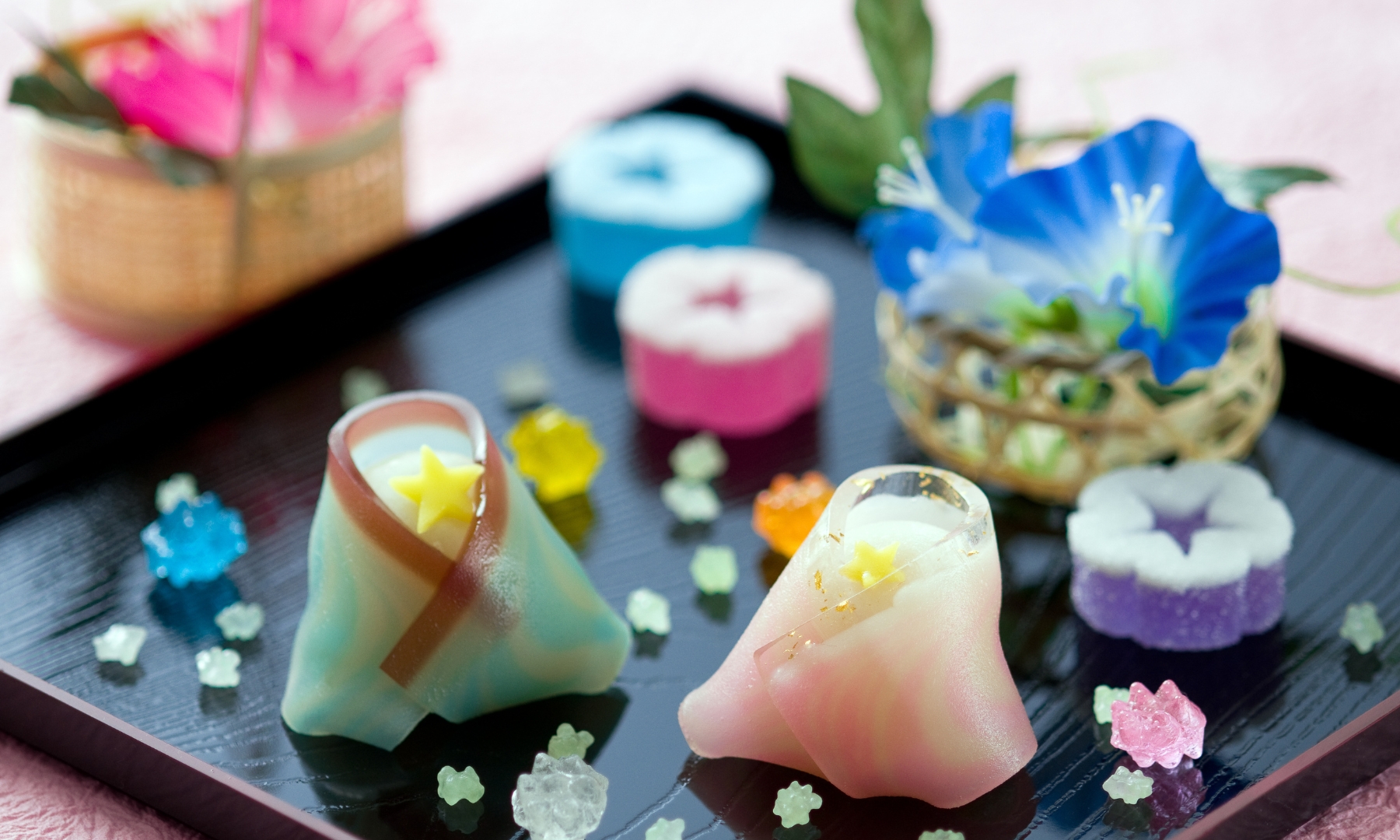
Final Thoughts
As you can see, there are so many delicious sweets in Japanese cuisine. I shared some of the most popular Japanese desserts but the truth is, food in Japan is ever-changing. New modern desserts appear every year especially in places like Harajuku and Aoyama. The best way to enjoy the best and the latest is to plan a trip to Japan to try Japanese sweet potatoes in various forms, green tea cookies, green tea mochi and all sort of delicious desserts with fresh fruits. You will find sweet red bean filling in almost all Japanese desserts, which makes sweet treats healthier and full in fibre.
Whether you want fluffy Japanese pancakes or the perfect Mont Blanc, Japan won’t disappoint when it comes to its delicious confectionary market.



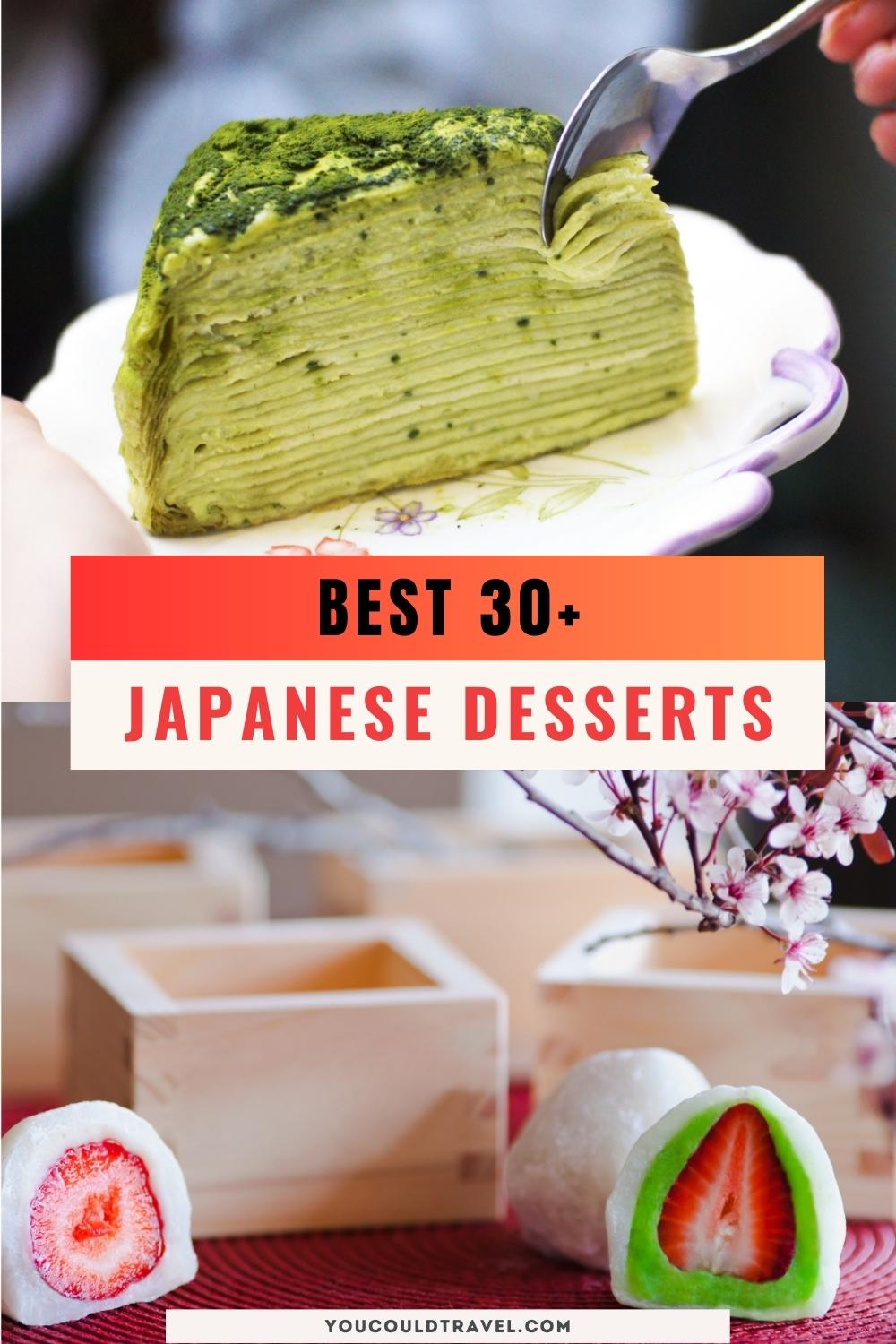
Frequently Asked Questions
What are popular Japanese desserts?
There are so many popular Japanese desserts to pick from. They vary in flavour and texture and intricacy. Here are some of the favourites:
Mochi: A soft and chewy rice cake made from glutinous rice, often filled with sweet red bean paste or other fillings.
Dorayaki: A dessert made of two small pancake-like layers filled with sweet red bean paste, custard or chocolate.
Taiyaki: A fish-shaped cake typically filled with red bean paste, custard, or other sweet fillings.
Matcha ice cream: A popular green tea-flavored ice cream. A little bitter but so delicious.
Daifuku: Mochi filled with sweet red bean paste, sometimes containing fruit or other fillings.
Anmitsu: A dessert consisting of agar jelly, fruits, and red bean paste, served with a sweet syrup.
Dango: Chewy dumplings made from rice flour, typically served on skewers and flavoured with various sauces. You will find it on street food stalls.
Wagashi: A category of traditional Japanese sweets, often made with sweet bean paste, mochi, or fruit. Very visually appealing and served during Japanese tea ceremony.
Kakigori: A shaved ice dessert flavoured with various fruit syrups and sometimes topped with condensed milk or other toppings. Very popular during summer in Japan.
What is a classic Japanese dessert?
A classic Japanese dessert is Wagashi, a traditional Japanese confectionery that is often served with tea, particularly during tea ceremonies. Wagashi is made using natural ingredients such as sweetened azuki (red bean) paste, mochi (glutinous rice cake), agar-agar, and various types of sugar. The desserts are typically crafted to reflect the seasons, incorporating seasonal ingredients and themes.
One of the most famous types of Wagashi is the delicate Nerikiri. Nerikiri is made from white bean paste wrapped in a sticky, mouldable rice flour. You need serious skills to shape these into flowers, leaves and natural motifs. There are specialised tools and techniques for this. You can take a nerikiri class in Japan to learn how to do them yourself.

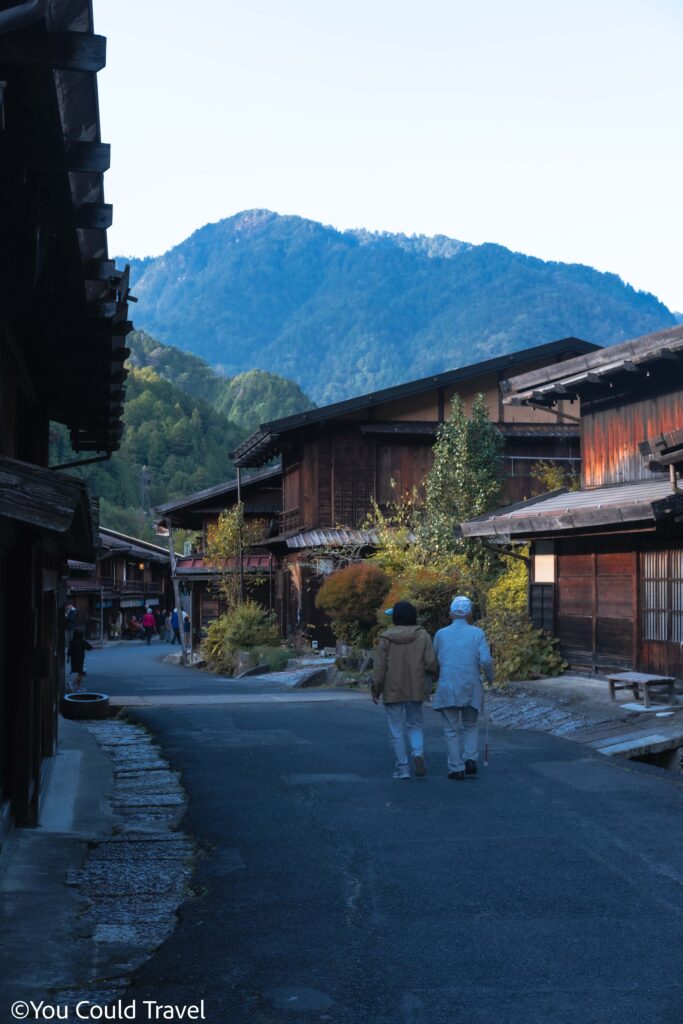




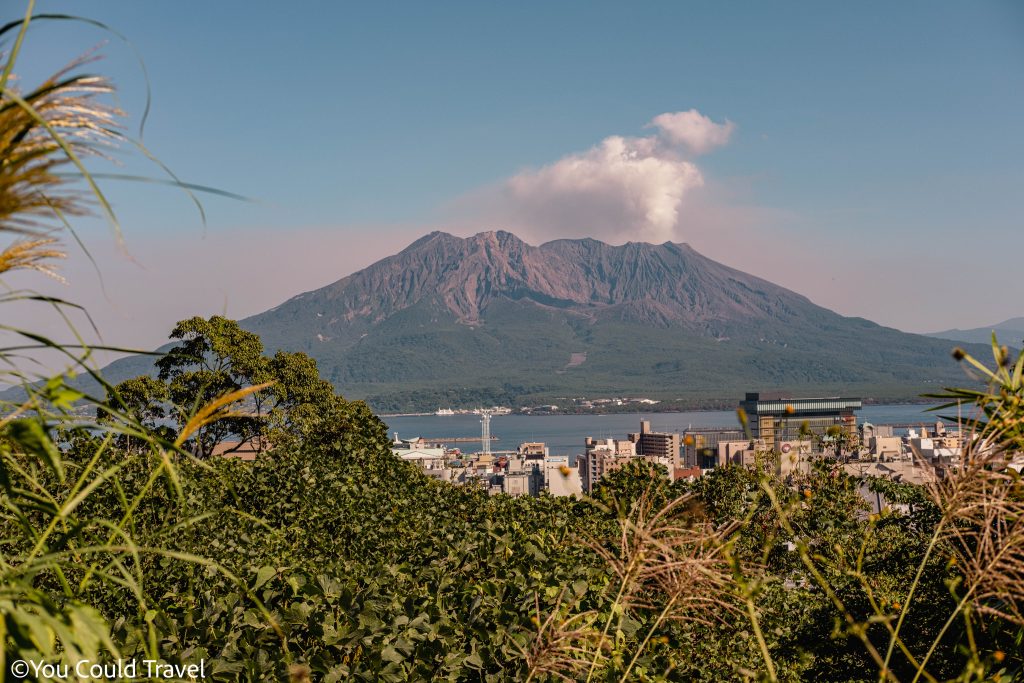


Leave a Reply